#and between hopping between hotels and airbnbs and taking ubers to our viewings
Explore tagged Tumblr posts
Note
A few months back, I asked if it was okay to write using Clora and Seb. Finished the work - thought I'd lost it on my hard drive and a virus scan located it.
Not sure if it's sad or happy, but the basic premise of it is Clora getting frustrated/upset at Sebastian and Sebastian comforting her, Sebastian getting upset at a predicament Clora's in and Clora comforting him, and them both getting frustrated/upset and having to comfort each other.
If you'd rather I didn't post it, that's fine too, but just wanted to test the waters and double check that you'd be okay with it if I gifted it to you via AO3, or see if you wanted a sneak peak of it before posting it.
OMG im so happy you were able to find it and recover the work you did!!😭🙏 AND YES OF COURSE YOU CAN POST IT AAA I CANT WAIT TO READ IT!! you can DM it to me first if you want, but i also dont mind if you post it straight away on ao3!! IM LOOKING FORWARD TO IT SM AAARGHHHA💖💖💖IT SOUNDS ANGSTY WE LOVE THE HURT/COMFORT I HOPE MY HEART CAN HANDLE IT🥺💖💖TY AGAIN FOR USING CLORA AND SEB AND TAKING THE TIME TO WRITE SOMETHING ABOUT THEM😭

@sunshine-goblin AAA THANK YOU!!! im honoured its your fav fanfic AND ALSO THE LONGEST YOUVE READ BAHAHAA fr, when you say its as long as four books in lotr it rly makes me realize how insane i am😃👍 aw IM GLAD I COULD INSPIRE YOU TO DRAW MORE AND WRITE AS WELL😭 I was curious so i creeped you and everyone go look at their HL blog @sunshines-legacy your MC is so cute and so is your art🥹💖 as for tips on writing a longfic and brainstorming and motivation and stuff, my motivation was my brainrot and unhappiness with the canon story/ending LMAOO, and looking at the story of the game and playing around with what i was unhappy with/what i WISHED could have happened instead, was a lot easier than just coming up with plotlines from scratch. but something i highly recommend is just OUTLINING and making a timeline, one of my fav parts of writing was just putting on some cafe ambience in the background and doing stream of conscious type word documents where id just barf ideas and then worry about making it pretty later....like look at how many versions of the same chapter i have BAHAHA or like different renditions bc i couldnt decide if id wanna keep a scene/what order, so id make a timeline and keep smoothing things out until i was happy with it and whatnot


brainstorming is defs my fav part of the process and the most helpful part to me. just getting a blank document and writing stuff you want to happen without worrying about how it connects to the story, and then a lot of the times as i was doing that id just keep going and it would kinda tie itself together/id come up with a solution as i was writing / once the ideas kept flowing. so basically : TIMELINES AND OUTLINES I VERY MUCH RECOMMEND, but very low pressure and barebones ones. for example, this is what my outlines/brainstorming look like


its honestly just me talking to myself LMAO, and a lot of the time ill interject and be like "OH YEAH AND THEN THIS CAN HAPPEN" as the ideas come while im writing BAHAHA. its a super fun process and honestly nothing feels better than just getting hit with that flash of inspo, and since its all very low effort theres no pressure to actually write well and its just a chill fun time AND GOOD LUCK WITH YOUR OWN PROCESS / WRITING💖💖💖it can be difficult but HOPE U HAVE FUN TOO💖💖

@a-little-lysdexic WAIT REALLY?? LMFAOO OMG THATS CRAZY....SAME BRAIN...🤝🤝...that would trip me up so much if i were you omg BAHHAHA but aside from having similar tastes in names, IM GLAD YOU LIKE MY ART AS WELL, TYY💖💖💖

THANK YOUUU im glad you're liking it!!! and that its taking over your life BAHAHA💖💖 the video you're thinking of was by @silverxstardust for chapter 13 of my fic, and you can watch the video here! (AND TY AGAIN TO SILVERXSTARDUST FOR DOING THIS!)
youtube
#ask#yapped so much#IM SO EXCITED TO READ YOUR FIC ANON U DONT UNDERSTANDDD#also for anyone interested in updates on my living situation i am currently in a dingy and sketchy af motel#but we went to a viewing for a place yesterday and we loved it so we just paid the deposit immediatley and started filling out the forms#we paid the deposit to put us on top but its still not confirmed whether we have it but I HOPE SO GAHH ITS THE PERFECT PLACE#and the perfect location we dont drive and theres literally a grocery store right outside#we wouldnt be able to move in till october 1st tho so all my stuff will just stay with uhaul and im going back to my moms on tuesday#I NEED MY MOMMYYYYYY ive been eating like such trash LMFAO#and between hopping between hotels and airbnbs and taking ubers to our viewings#me and my roommate have spent like the equivalent of 1 months rent just in the span of like a week#feelsbadman#we dont think about that tho tralalalaala#now that we have a place i can relax and stop apartment hunting and start drawing and writing again woo
117 notes
·
View notes
Photo

Singapore is one of our favourite places in Asia and we’ve visited many times. This island nation, that’s both a city and a country, is an easy introduction to the continent as it’s clean, efficient, and English is widely spoken. There’s plenty to do, a fascinating culture, and lots of delicious food.
This ultimate Singapore itinerary is ideal for first-time visitors to the city and will take you to unique neighbourhoods that highlight Singapore’s multicultural heritage.
You’ll see a wide variety of architecture from colourful traditional shophouses to futuristic skyscrapers, visit some fun attractions, and have time for many tasty meals along the way.
Three days in Singapore is a good amount of time to get an overview of the city and see the highlights, but you could easily spend a week here.
If you only have one day in Singapore, then pick and choose your favourite activities from the itinerary below—I recommend focusing on the Marina Bay area as it’s so unique. If you have four days or more, I have included additional suggested activities at the end of the post.
Prices quoted below are in Singapore dollars. The current exchange rate is S$1 = 0.73 USD, 0.60 GBP and 1.07 AUD.
Where to Stay in Singapore
The Best Neighbourhoods to Stay in Singapore
Choosing a central area to stay will help you make the most of your time in the city. I recommend finding a hotel in one of these areas which are all convenient for this Singapore itinerary:
Marina Bay – Fantastic views, beautiful riverfront area, close to top Singapore attractions like Gardens by the Bay, expensive.
Bugis – Convenient location between Marina Bay and the Kampong Glam and Little India neighbourhoods. We stayed here on our most recent visit and could walk to most places on this itinerary. Budget and luxury accommodation available.
Chinatown – Good value hotels not too far from Marina Bay.
Orchard Road – A good option if you want to be close to shopping malls and embassies (we’ve gotten visas for Thailand and Indonesia here). The Singapore Botanic Gardens are close by, but it’s less convenient for the other areas in this itinerary.
Recommended Hotels in Singapore
Andaz Singapore, Bugis
Andaz Singapore is our new favourite place to stay in Singapore. This hip hotel is in the perfect location just a few minutes’ walk from trendy Haji Lane and the traditional architecture of Kampong Glam.
Little India and the Colonial District are also walkable and Marina Bay is a 30-minute walk or two stops on the MRT (the hotel is connected to Bugis station).
Our room at Andaz Singapore
We loved the spacious, stylish rooms with fantastic city views from the floor to ceiling windows, free minibar, and all the mod cons like a Nespresso machine. The bed was so comfortable it was hard to leave.
A view of the Singapore Flyer, Gardens by the Bay and Marina Bay Sands from the infinity pool at Andaz Singapore
The views from the infinity pool and rooftop bar (which features cool teepees) are also stunning.
You can help yourself to complimentary hot and cold non-alcoholic drinks and snacks in the Sunroom all day. Our room rate didn’t include breakfast, but we preferred ordering room service anyway or there are many cafes nearby.
Check the latest prices at Andaz Singapore here.
Treetops Executive Residences, Orchard Road
We stayed at Treetops for a family reunion earlier in the year and loved it. The one and two bedroom apartments have a four-night minimum stay, so it’s good for longer trips, especially for families.
The apartments are spacious and comfortable and have everything you need to self-cater, but a buffet breakfast is included in the rate. There’s a lovely large pool surrounded by tropical vegetation.
Marina Bay Sands
Marina Bay Sands is the ultimate splurge—Singapore’s most famous hotel features the world’s largest rooftop infinity pool. Expect crowds and high prices, but the views might just be worth it. We haven’t stayed here yet, but we are tempted.
Budget Accommodation
There are plenty of hostels and capsule hotels in the Bugis and Kampong Glam area such as Beary Best and ZEN Hostel Bugis.
Chinatown is a good area to look for budget hotels. The Bohemian Chic is a well-reviewed, stylish hostel and Hotel Mono has attractive ensuite double rooms.
Search for more hotels in Singapore here.
Airbnb also has affordable private rooms and apartments throughout the city.
Singapore Transport
While walking around Singapore we’ve discovered cool streets like Armenian Street
Singapore is easy to get around. It’s a walkable city and we always find gems when we’re on foot, but the heat makes walking exhausting (and sweaty) in the middle of the day.
Save your energy by hopping on the clean, efficient, and inexpensive MRT metro. You can buy tickets as you go or purchase an ez-link card for S$12 which includes S$7 credit. Most trips are only S$1–2.
You could also consider a Singapore Tourist Pass which costs S$30 for unlimited rides for three days (with a $10 refundable deposit).
Another easy option for getting around is the Grab app (there’s no Uber here) which makes it easy to call a taxi. Short rides cost around S$10.
We use Google Maps for walking or public transport directions.
Singapore’s Changi Airport is one of the best in the world so allow time before your flight to explore the various gardens and attractions. You can get the MRT to/from the airport but we find it easier to get a taxi which costs about S$15–20 to Bugis.
The Best Time to Visit Singapore
You can visit Singapore at any time of year.
We have travelled to Singapore in many different months and the weather is always the same—hot, very humid, lots of clouds, and often short rain showers (which are usually quite refreshing).
It has the least amount of seasonal variation of anywhere we’ve ever visited, so I wouldn’t let the weather influence your decision on when to visit.
Check for local holidays and festivals when you are planning your trip to Singapore. There is often a vibrant event to enjoy like Chinese New Year in January or February or Diwali in Little India in October or November.
Map for Singapore Itinerary 3 Days
This Singapore map has all the recommended sights for this itinerary. Activities for each day are pinned with a different colour—Day 1 in blue, Day 2 in red, and the various options for Day 3 in green.
Singapore Itinerary Day 1: Colonial District and Gardens by the Bay
National Museum of Singapore
The National Museum of Singapore (S$15) is a great introduction to the history of the city and will give you an understanding of its multicultural roots. It’s housed in an elegant Neo-Palladian building dating back to 1887 with a towering Indian rubber tree outside.
I recommend starting on the second floor at the Glass Rotunda. The Story of the Forest exhibit was created by the Japanese digital arts collective teamLab and brings drawings of the Malay Peninsulas’s jungle and wildlife to life.
It’s a unique exhibition and will lead you down to the first floor where you can work your way through the history of Singapore.
We spent about two hours here but still didn’t see all the exhibitions.
If you’d prefer to learn about the city’s history from a guide rather than a museum, you could take this Singapore’s Old Colonial District Walking Tour instead.
Transport: We walked from the Andaz Singapore Hotel in Bugis (20 minutes). The nearest MRT station is Bencoolen Station on the Downtown line.
Explore the Colonial District
The National Museum is located in Singapore’s Colonial District so after your visit you could take a stroll through the area and visit 150-year-old St Andrew’s Cathedral and Fort Canning Park.
One of the top Singapore tourist spots is also nearby. The Long Bar in the historic Raffles Hotel is where the Singapore Sling cocktail was invented and peanut shells are brushed onto the floor. We’ve still not been as it’s expensive and touristy, but if it’s on your bucket list, go for it!
One of our favourite places to stop for a cake break is Fabulous Baker Boy on the edge of Fort Canning Park.
For lunch you could head to the Raffles City shopping mall food court (these are always a good, inexpensive option in Singapore) or walk down to Boat Quay (about 20 minutes) for a meal overlooking the river.
We like the burgers at Hans im Glück (with a wide variety of veggie options) and tapas at My Little Spanish Place or there’s plenty of seafood on offer. Here are some more ideas on where to eat at Boat Quay.
Burgers with a view at Hans im Gluck at Boat Quay
Gardens by the Bay
Waterfall in the Cloud Forest dome at Gardens by the Bay
Gardens by the Bay is one of the best places to visit in Singapore and is my number one must-see for any trip to the city. Try to avoid visiting on weekends if possible as it gets very busy.
You’ll want to time your visit to the gardens so that you’ll be finished by just before sunset as this area is attractive after dark. If you arrive by around 2 or 3pm you should have plenty of time.
The extensive outdoor gardens are free, but at this time of day you’ll probably be eager to get inside and the paid conservatories are superb.
Both climate-controlled domes—the Flower Dome and the Cloud Forest—are worth visiting, but if you have limited time, choose the Cloud Forest which is the most unique and features a large waterfall. A combined ticket is S$28.
You can save 18% off the entrance price and skip the ticket queue by buying your Gardens by the Bay tickets online at Voyagin.
Transport: Gardens by the Bay is a 30-minute walk from the Colonial District or the nearest MRT station is Bayfront on the Downtown and Circle lines.
Marina Bay Sands Sunset Cocktail
Sunset view from CÉ LA VI SkyBar at Marina Bay Sands
Marina Bay Sands is Singapore’s most iconic building. Three 55-storey towers are topped by a boat-shaped structure that features the famous infinity pool, gardens, and an observation deck. The building houses a hotel and many shops and restaurants.
Before sunset I recommend heading to Marina Bay Sands for an amazing view from the top as the sun goes down and the city’s skyscrapers light up.
I think it’s better value to pay for a drink at the CÉ LA VI SkyBar (minimum spend S$22) than pay S$23 for the Sands SkyPark Observation Deck. Sunset times vary from 6.50pm to 7.20pm depending on the time of year.
Last time we visited on a Sunday there was a long queue to get up, so allow time for this and consider making a reservation if you’d like a seated table (standing tables are on a first come, first served basis).
Note that the bar has a dress code from 6 pm—no swimwear, singlets, sleeveless shirts, and flip-flops are allowed for men. There is no dress code on Mondays, Tuesdays and Sundays.
If you want to swim in the famous infinity pool, you’ll have to stay at Marina Bay Sands.
Transport: It’s about a 10-minute walk from Gardens by the Bay to Marina Bay Sands.
Supertrees Light Show
The Supertrees and OCBC Skyway during the light show with Marina Bay Sands in the background
Once darkness has fallen head back down to Gardens by the Bay to my favourite part—the Supertree Grove. These futuristic trees are 25 to 50 metres tall with steel trunks covered in orchids, ferns, and climbing tropical flowers. Many of the trees generate solar power and collect rainwater.
The Supertrees are best seen lit up at night and the free Garden Rhapsody light and sound show takes place at 7.45pm and 8.45pm every day.
You can also get up close to the large canopies on the 22-metre-high OCBC Skyway. If you bought Gardens by the Bay tickets online with Voyagin this is included in the price; otherwise it’s $8SGD (last admission 8pm).
Satay by the Bay is the best place in the area for a quick, inexpensive dinner. The large, open-air food court features local specialities like satay, chicken rice, and BBQ seafood.
As vegetarians we head to the Indian stall for a masala dosa (crispy rice flour pancake stuffed with potato curry) which only costs S$3. It’s a 10-minute walk from the Supertree Grove.
There’s lots more to do in the Marina Bay area at night. I’ve put the rest in the itinerary for Day 2, but if you are feeling keen, you could continue on to explore more of the area including Clarke Quay and the Singapore Flyer.
Transport: The nearest MRT station is Bayfront on the Downtown and Circle lines.
Day 2: Exploring Singapore’s Multicultural Heritage and Marina Bay at Night
Singapore is a multicultural city and the three largest ethnic groups are Chinese, Malay, and Indian. On your second day in Singapore explore three of Singapore’s distinct ethnic neighbourhoods.
Little India
Tan Teng Niah in Little India
Little India is home to Singapore’s Indian community and is a vibrant, bustling place that really does remind us of India with its smells of incense and sounds of Bollywood music.
In Little India you can:
Explore the colourful wooden shophouses.
Visit the extravagant Sri Veeramakaliamman Hindu Temple.
Take photos of Tan Teng Niah, a vibrant Chinese villa built in 1900.
Shop at the lively Tekka Centre and Mustafa Centre (open 24 hours).
Eat cheap South Indian food at one of the many vegetarian restaurants like Komala Vilas. Try a masala dosa (rice flour pancake stuffed with curry) or a thali where mounds of rice and curries are served on a banana leaf.
Witness the colourful kavadi procession if you visit during the Thaipusam Hindu Festival in January or February. Some devotees pierce their bodies and tongues with spikes.
Devotee at the Thaipusam Festival
Transport: Little India is walkable from the Bugis area (where we stayed) or take the Downtown or North East MRT line to Little India station.
Kampong Glam
Haji Lane
Kampong Glam is Singapore’s Muslim and Arab neighbourhood. It’s Singapore’s oldest urban quarter—in 1822 it was allocated by Sir Stamford Raffles (the founder of the city) to the Malay and Arab communities.
There are some lovely colourful shophouses, mosques, and a hipster scene with trendy cafes and bars.
In Kampong Glam you can:
See the golden domes of Sultan Mosque.
Learn about the Malay community in the Malay Heritage Centre (S$6).
Shop in the funky boutiques and admire the street art on Haji Lane.
Listen to live music at one of the pavement bars on Haji Lane in the evenings.
Transport: It takes about 15 minutes to walk between Little India and Kampong Glam or take the MRT Downtown line to Bugis.
Chinatown
Chinatown was once home to Singapore’s Chinese immigrant community, but it’s now a mix of cultures with historic temples and trendy cafes. It’s the only Chinatown in the world with a Buddhist temple, mosque, and Hindu temple on one street.
In Chinatown you can:
Visit the beautiful Buddha Tooth Relic Temple (Buddhist).
Compare it to the Thian Hock Keng Temple (Taoist).
See the oldest Hindu temple in Singapore, Sri Mariamman.
Learn about Singapore’s earliest immigrants at the Chinatown Heritage Center (S$18).
Grab a bite to eat at one of the open-air eateries on Chinatown Food Street (from 11am–11pm) or Maxwell Hawker Centre.
Eat vegetarian Peranakan dishes at nearby Whole Earth.
Experience lively Chinese New Year celebrations if you visit at the right time (usually January/February).
Transport: Take the MRT Downtown line from Bugis to Chinatown station.
Riverside and Marina Bay Walk
It’s worth spending two nights at the Marina Bay area as there’s lots to see. On the second night, I recommend taking a walk along the Singapore River, which is one of my top things to do in Singapore at night when it’s cooler and the skyline views are fantastic.
This walk takes about 40 minutes plus stops (there are lots of photo opportunities).
If you don’t want to walk, you could take a Singapore River Cruise on a bumboat from Clarke Quay (40 minutes, S$25). If you book the river cruise in advance with Voyagin you can save money.
Start the walk in Clarke Quay and continue through Boat Quay—both have lots of bars and restaurants overlooking the water. It’s a little touristy but fun and the views are superb.
The view from Boat Quay
Continue down the river past Fernando Botero’s Bird sculpture and the grand Fullerton Hotel to the Merlion fountain.
This iconic statue has the body of a fish and the head of a lion that shoots water from its mouth. The body symbolises Singapore’s humble origins as a fishing village and the head represents its original name Singapura or Lion City in Malay.
From this area you can see Spectra, a free light and water show that takes place every night at 8pm and 9pm (also at 10pm on Fridays and Saturdays). This side of the bay will give you a view of the colourful laser beams projecting from Marina Bay Sands.
Spectra light show from the Merlion fountain
You could also try to see a later show on the other side of the bay in front of Marina Bay Sands for a different perspective. You’ll be able to see the projections on water from the seating area outside The Shoppes (the shopping mall at Marina Bay Sands).
From Merlion cross over the Esplanade Bridge to the Esplanade Outdoor Theatre where there are often free performances.
The view from the other side of the Esplanade Bridge
If you are hungry, the Makansutra Gluttons Bay food court is next to the Esplanade.
A little further down the river is the impressive Helix Bridge which connects to Marina Bay Sands, so cross over here if you want to catch the light show from that side.
The Helix Bridge takes you to Marina Bay Sands
Or continue a little further along the river to the Singapore Flyer to take your Singapore sightseeing up high.
Transport: From Chinatown it’s a 15-minute walk to Clarke Quay or take the MRT Downtown line to Fort Canning station or the North East line to Clarke Quay.
Singapore Flyer
A ride on this huge observation wheel takes 30 minutes and costs S$33. I wasn’t sure it was worth it at first, but once we reached the top (at 165 metres) and started descending, the view was truly spectacular.
You can see Marina Bay Sands, Gardens by the Bay, downtown skyscrapers, and the whole of the Bay.
Transport: I recommend walking here along the river, but to get back to your hotel the nearest MRT station is Promenade on the Downtown and Circle lines.
Day 3: Universal Studios Singapore or Shopping and Gardens
On your final day in Singapore you can choose the activity that interests you most. If you are a theme park fan, like us, I recommend a visit to Universal Studios Singapore on Sentosa Island.
If rides aren’t your thing, you might prefer shopping in the malls on Orchard Road and visiting the nearby Botanic Gardens. I’ve included some other suggestions below.
Universal Studios Singapore
Battlestar Galactica roller coaster at Universal Studios Singapore
Universal Studios Singapore is a fun day out with a wide variety of movie-themed rides and attractions. It’s not a huge park so if you arrive at the 10am park opening (which I recommend to avoid the crowds), you can be done by mid-afternoon and be back at your hotel for a much-needed refreshing swim.
Our favourite rides are Battlestar Galactica, a duelling roller coaster (ride both sides!); The Revenge of the Mummy, a fast roller coaster in the dark with some surprises; Transformers, an intense 3D experience; Jurassic Park, a fun water ride; and Waterworld, a live show with impressive stunts.
Read our guide to the best Universal Studios Singapore rides for more details and tips on avoiding long queues.
We always buy e-tickets in advance to avoid the queues and because you can save from 5% to 20% by booking here with Voyagin. Full price adult tickets are S$79.
Transport: Take the MRT to HarbourFront station and connect to the Sentosa Express monorail to Waterfront station, which is a short walk from the park. The monorail is a little more expensive than standard MRT rides (S$5 return), but you can use your MRT card to get straight on. The journey will take about 30 minutes from Bugis.
Alternatively, take the cable car to Sentosa Island to enjoy the view. From HarbourFront MRT station, ride the cable car to Imbiah, then take the Sentosa Express monorail one stop to Waterfront station. Voyagin offers discounts on Universal and Cable Car packages.
Singapore Botanic Gardens and Orchard Road Shopping
ION Orchard mall
Shopping fans might prefer to head to the Orchard Road area instead for a day of shopping in the many (blissfully air-conditioned) malls.
Not far from Orchard Road are the Singapore Botanic Gardens, which date back to 1859 and are a UNESCO World Heritage Site.
These extensive gardens are a lovely place for a stroll, but due to the heat it’s best to visit in the early morning or late afternoon. When we stayed on Orchard Road I liked running here at dawn. I recommend starting your day here and shopping in the afternoon.
The gardens are open from 5am to midnight every day and entrance is free to most of the gardens. There is a S$5 fee for the National Orchid Garden which opens from 8.30am (last entry 6pm)—there are 1000 species and 2000 hybrids on display.
The futuristic-looking ION Orchard mall is one of the most popular on Orchard Road with everything from luxury brands to high street fashion. All the malls have food courts for inexpensive local dishes and there are plenty of restaurants in the area.
Transport: Take the MRT to the Botanic Gardens MRT Station on the Downtown and Circle lines. From here to Orchard Road you could walk, but if you are feeling the heat, take a taxi or the MRT from Botanic Gardens to Newton on the Downtown line and change to the North South line to get to Orchard MRT station, which is next to ION Orchard mall.
Other Things to Do in Singapore
If theme parks and shopping don’t interest you, choose from one of these other Singapore activities:
Future World Exhibition at ArtScience Museum, Marina Bay – The Japanese arts collective teamLab created this cutting-edge interactive digital installation which will immerse you in various magical worlds. We went to their exhibition in Tokyo and it really is unique. Entry is at set times and it’s best to book in advance. Voyagin currently has a 32% discount on e-tickets.
TreeTop Walk in MacRitchie Reservoir – For a taste of the jungle and a peaceful escape from the city, head to this nature reserve where you can hike on nature trails including a free-standing suspension bridge which gives you a bird’s eye view of the forest canopy.
National Gallery Singapore – A large collection of Southeast Asian art in a beautiful historic building in the heart of the Civic District.
Singapore Zoo and Night Safari – These aren’t really our thing (we prefer seeing animals in the wild), but they are popular Singapore tourist attractions.
Singapore is a unique place with diverse neighbourhoods, fun attractions, and delicious food. I hope this Singapore travel guide has helped you plan your trip and feel free to ask any questions in the comments below.
If you are combining a trip to Singapore with Bali, check out our posts on the best things to do in Ubud (our favourite town in Bali) and our off-the-beaten-track Bali road trip. I’ve also written about how to get a 60-day Indonesian tourist visa in Singapore.
0 notes
Text
Days 168-174: Oberwesel and a Week on the Rhine
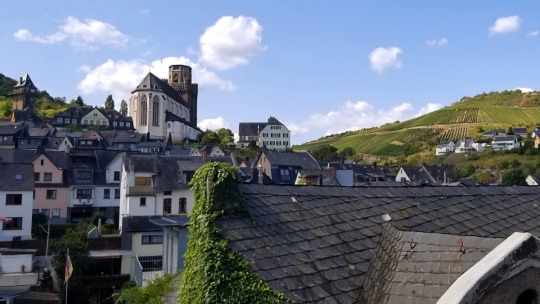
After a busy week in Munich, it was time for a scenic and relaxing week on the Rhine. We’d be staying in a charming little medieval town called Oberwesel, halfway between the cities of Frankfurt and Koblenz. None of the Germans we’d talked so far had ever heard of it. Which is a shame because it’s gorgeous–and also dead quiet. But we’ll get to that later.
We didn’t fit in quite as much sightseeing as we’d hoped, but we did get some rest and relaxation that we desperately needed. After nearly six months abroad and with only three weeks left, we were starting to feel the strain of constantly staying on the move.
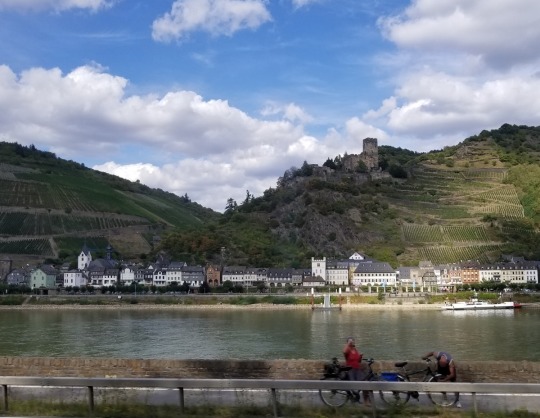
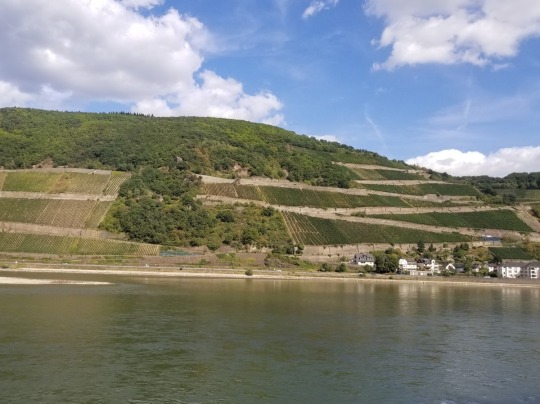
The train ride from Munich to Oberwesel was long but easy, and toward the end we got to enjoy a lovely preview of the vineyard-laced Rhine river valley.
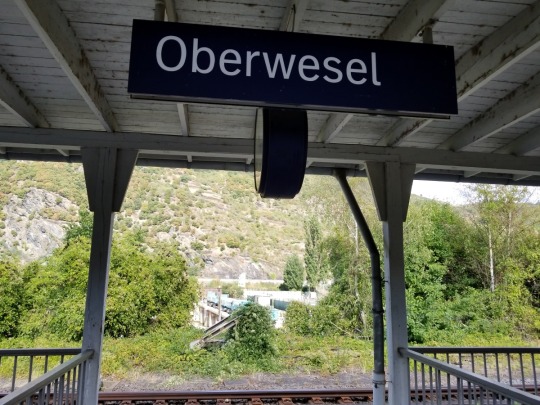
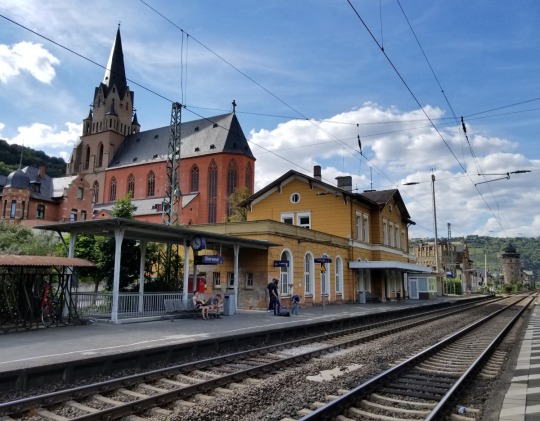
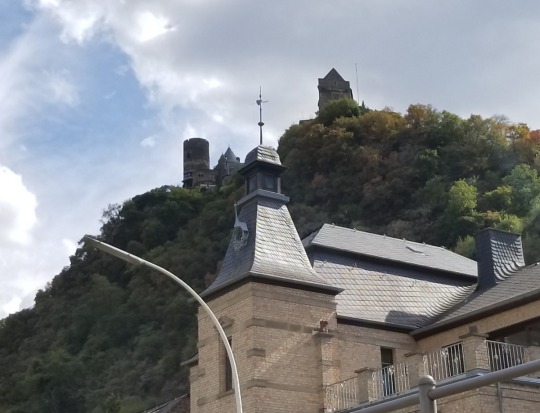
From the train station, we could just barely see the local castle–now a hotel and restaurant–peeking up from the top of a nearby hill.
Our host kindly offered to pick us up at the station and drive us to our Airbnb. It was only about half a mile away, and it might have been faster just to walk rather than wait, but after five and a half months on the road, we were grateful for any opportunity to not lug our packs across town.
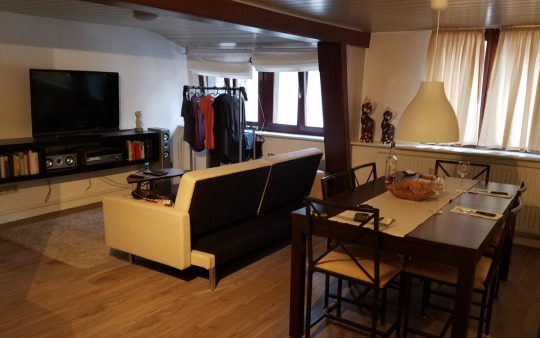
Our Airbnb flat was wonderfully spacious and comfortable, with a large dining/living room, a full kitchen, and two full bedrooms. It was one of our best homes through the entire trip, right up there with those in Avignon and Betws-y-Coed.
After settling in, we set about finding something for dinner. It was a Sunday evening, so the grocery store and most of the restaurants were closed. Luckily, we found a delightful little garden restaurant where we enjoyed some great food and a tasty local wine–a perfect introduction to the region.
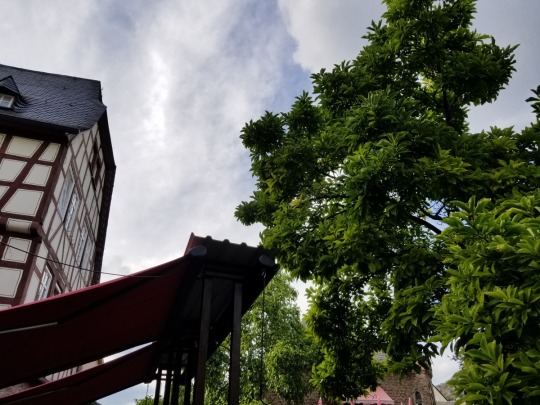
After dinner, there was still plenty of summer sunlight left, so we took a relaxing walk around the town.
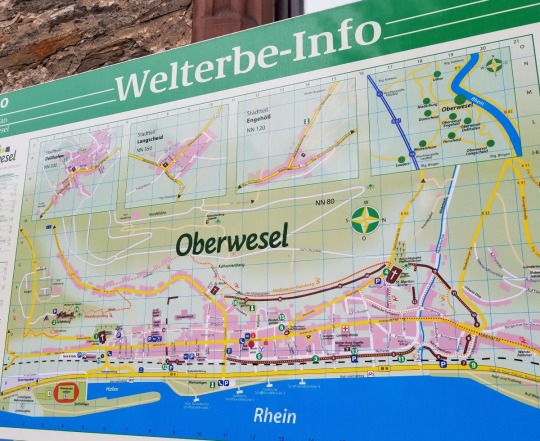
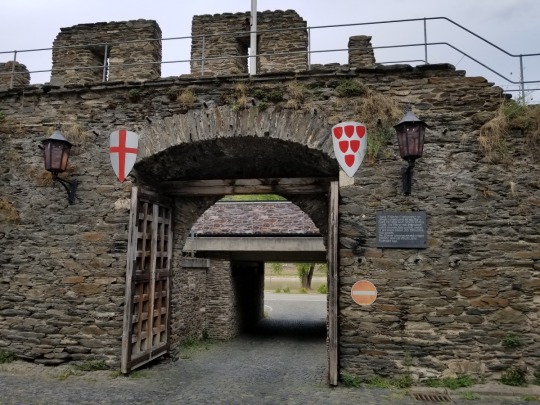
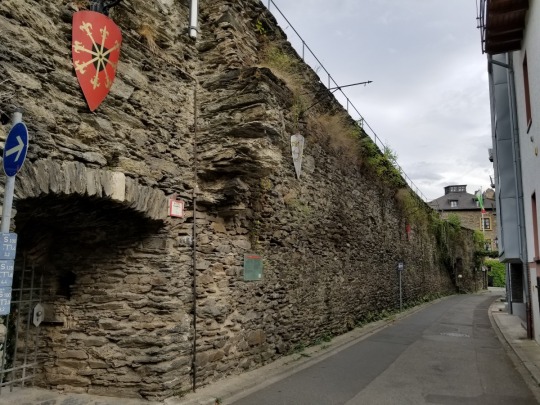
The Rhine is positively peppered with old castles and walled towns, and Oberwesel has the best-preserved medieval walls of them all. Inside these walls is a charming collection of buildings that mostly date back to the 19th and early 20th centuries, but some of the houses and churches date back to the Middle Ages.
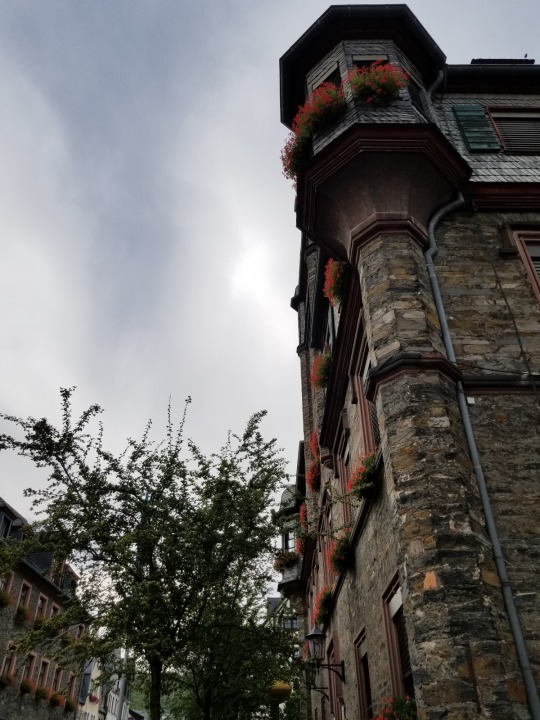
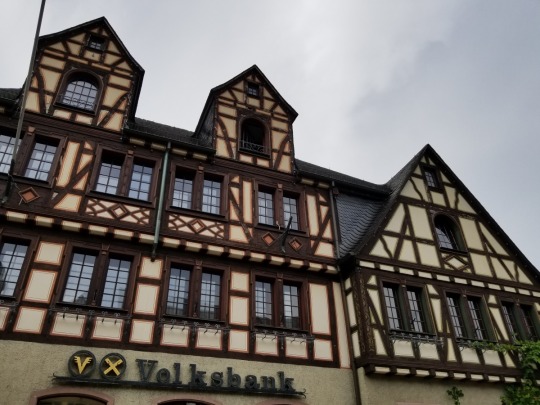
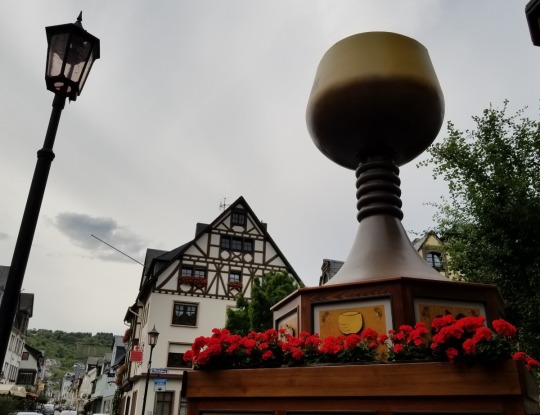
In the center of the town is a small but proudly ornamented market square, featuring the beautiful town hall, the local bank, and a statue of a giant wine glass.
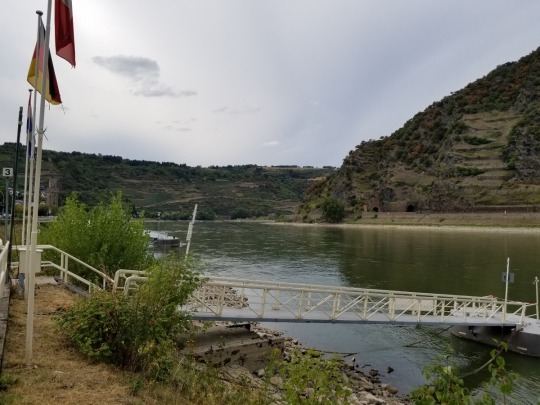
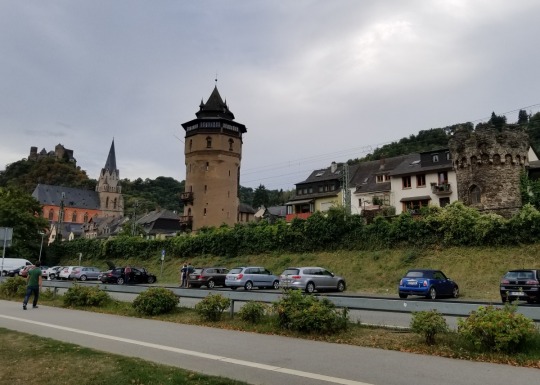
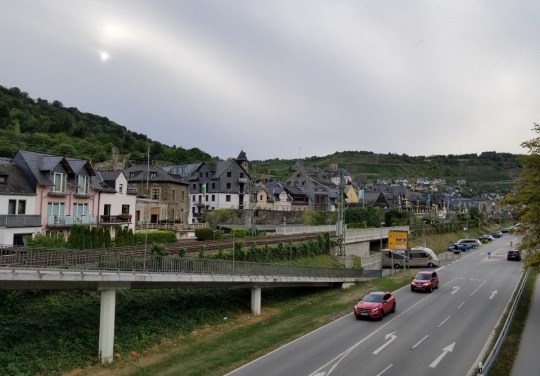
Going out through the walls, Jessica and I walked along the waterfront. We spotted the ferry office where we’d need to book tickets for our Rhine cruise on a later date, and we got some more great views of the town.
—
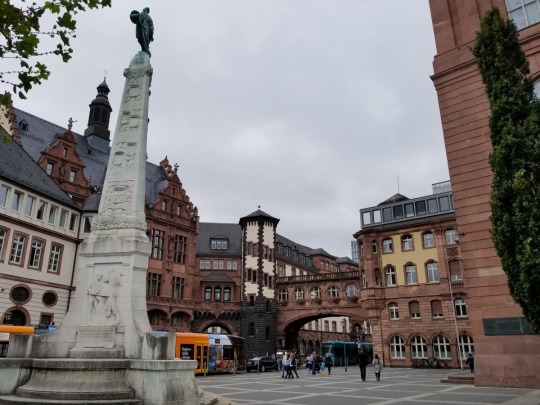
The next day we visited Frankfurt. It was a fun if somewhat unstructured day trip to a very historic city, and we had a pretty good time. We’ll cover it all in our next post.
—
Our first full day in Oberwesel was a lazy one. We slept in, walked over to the local TI to get some information on the local wineries and wine bars, then went grocery shopping. There are two main grocery stores in Oberwesel, and they're both on the far southern outskirts of town--nearly a mile away from where we were staying. Not having a car, we would have to balance the number of trips we wanted to make with the amount of stuff we wanted to carry each time we went shopping.
After bringing our food haul home and fixing up some lunch--consisting of fresh rolls, knackwurst, and sweet mustard--we went out to wander some more around town.
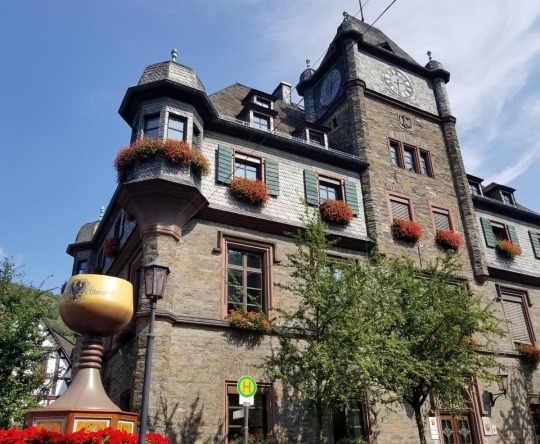
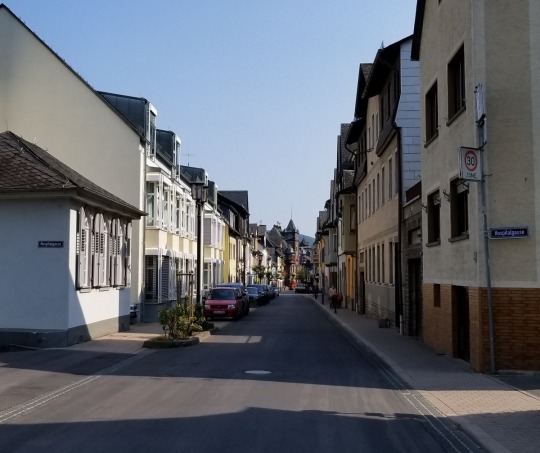
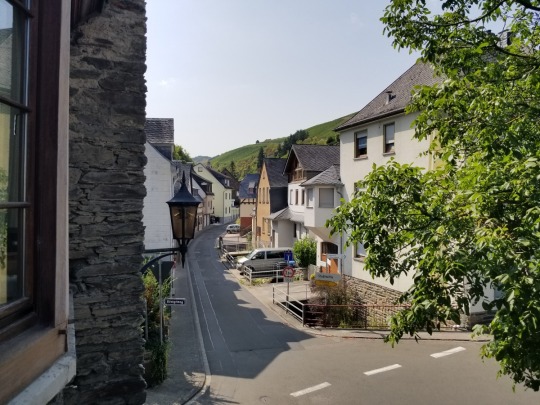
Even in the middle of a weekday, Oberwesel was almost depressingly quiet. It seems like these Rhine villages only really come alive on Fridays, Saturdays, and festival days, when all the wine shops open. Otherwise, a lot of stores seem to stay closed during the week or else keep very short hours. Many storefronts were boarded up, and "For Lease" signs were visible on almost every corner outside the main market square.
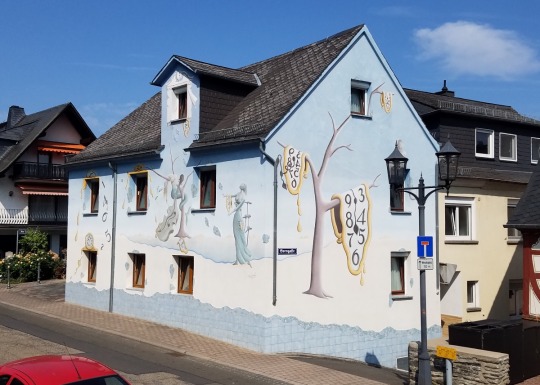
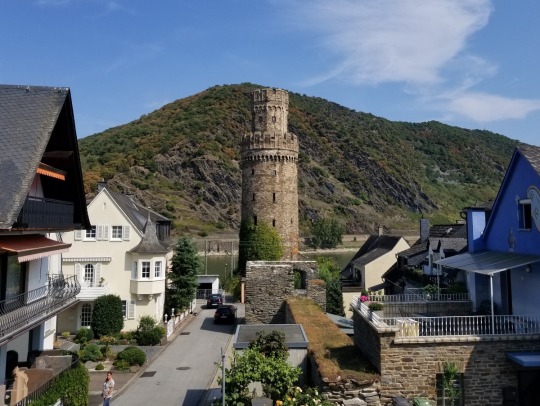
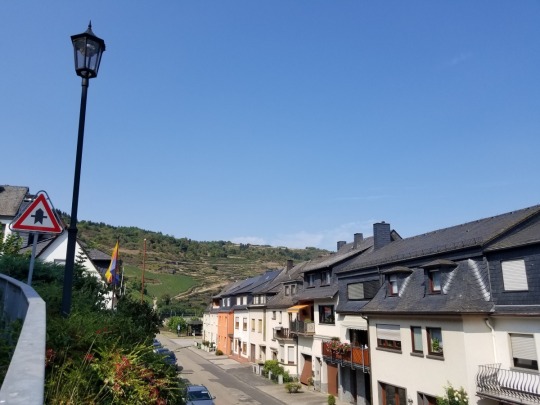
Still, despite the borderline ghost-town atmosphere, it was spectacularly picturesque.
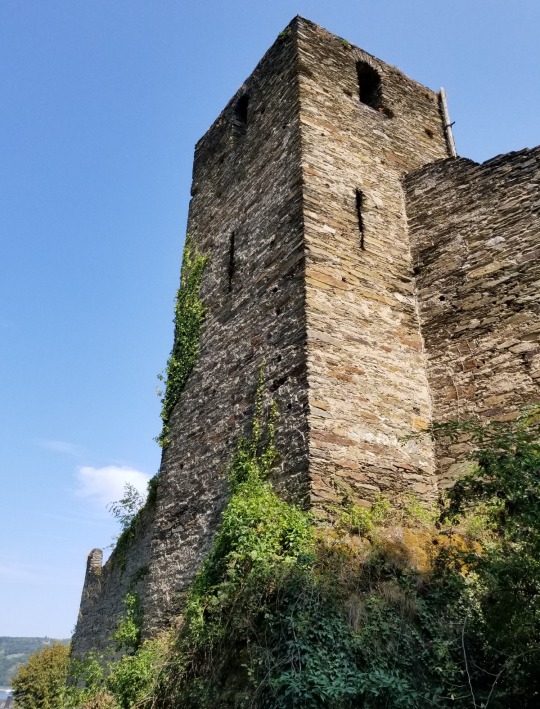
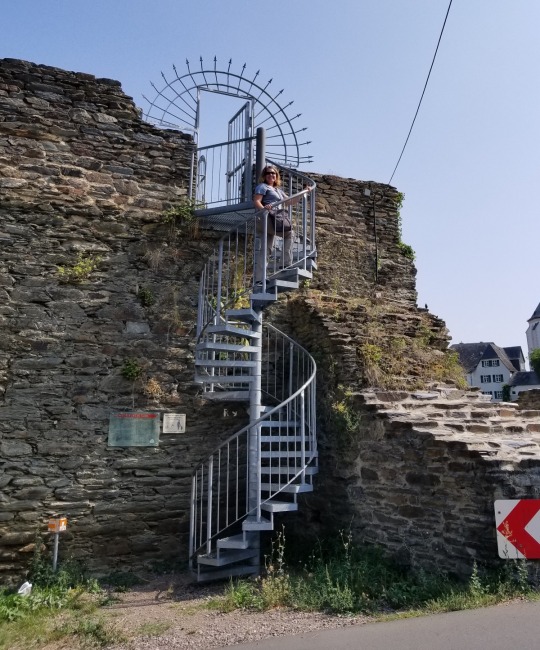
We wandered up toward the northern edge of town and eventually climbed a staircase leading up onto the walls. There was a group of wasps busy at work, but we gave them a wide berth and enjoyed some spectacular views of the town.
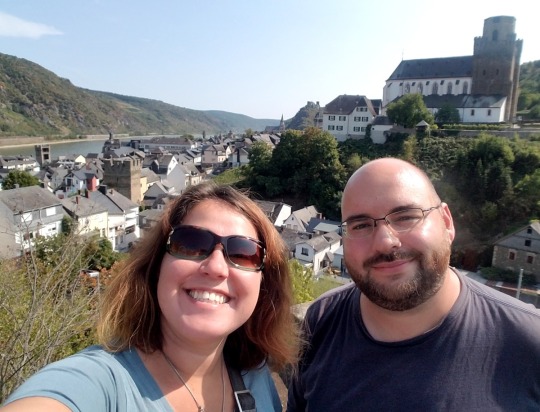
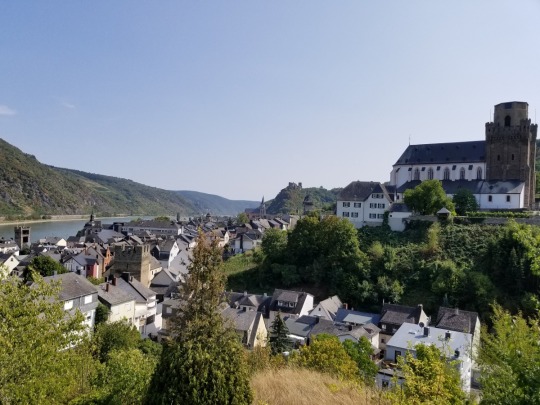
We took another path down from the wall and saw a little outdoor chapel, featuring icons of local patron saints.
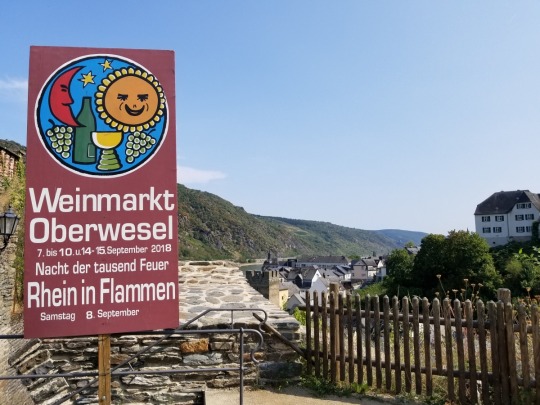
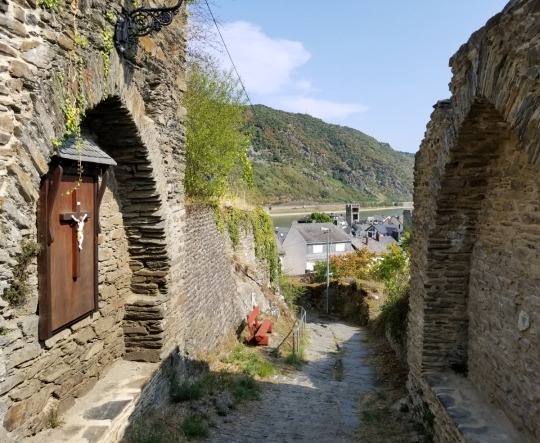
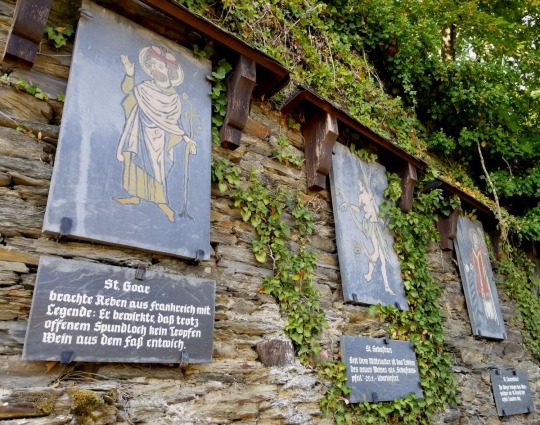
Making our way back along the wall into town, we stumbled upon an old hotel bearing a commemoration plaque. Apparently, this hotel is the site of one of the first known performances of the German national anthem ("Deutschland, Deutschland uber Alles…").
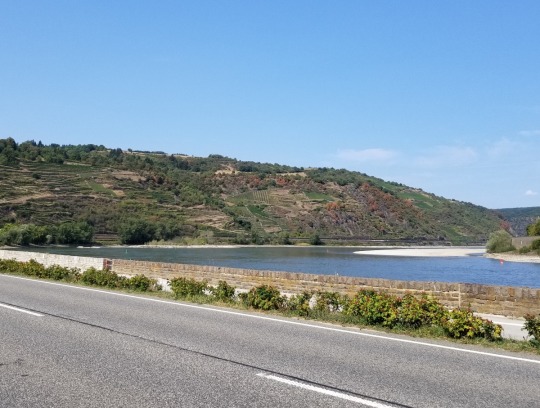
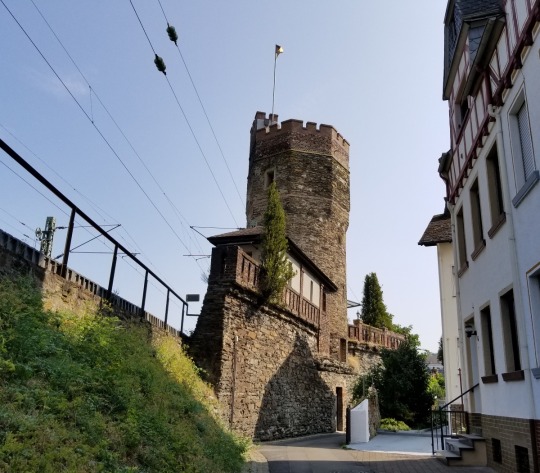
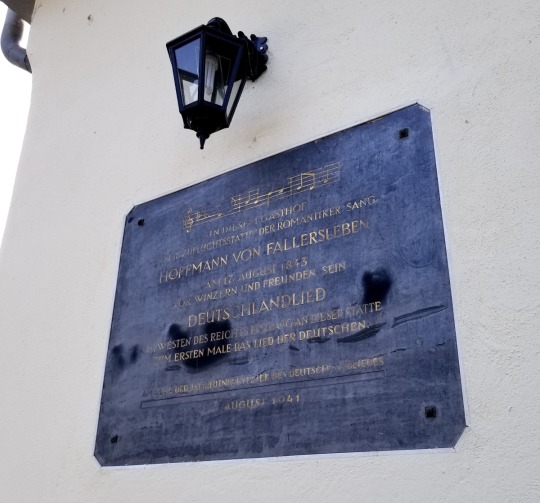
Ironically, while this song's call to put Germany Above All was tainted by the Nazis, it was originally intended as a call for liberalization. At the time it was written in the 1800s, Germany was divided into a confederation of autocratic states that put their rulers' squabbles and ambitions above the welfare of the people. The anthem's call was meant to encourage a united Germany where the good of the people came above political infighting.
On a corner near the market square, we found another testament to the damage done by the Nazi regime--a holocaust memorial dedicated to the town's Jewish residents who were deported or arrested by the Nazi regime.
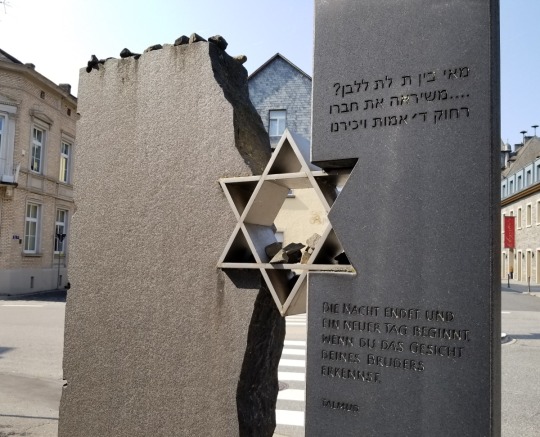
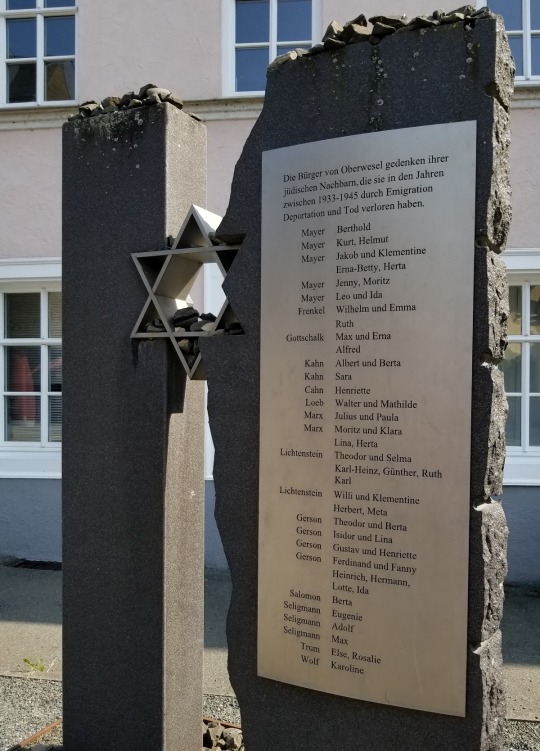
On a happier note, Jessica and I were able to make a purchase that we had long been looking forward too--a pair of Rhine wine glasses.
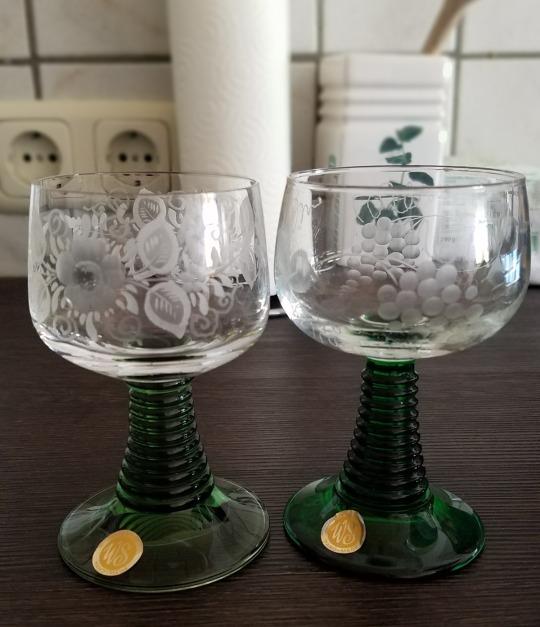
There seemed to be only a single tourist shop in town that was open that day, but they had a great selection of Rhine glasses and other souvenirs.
—
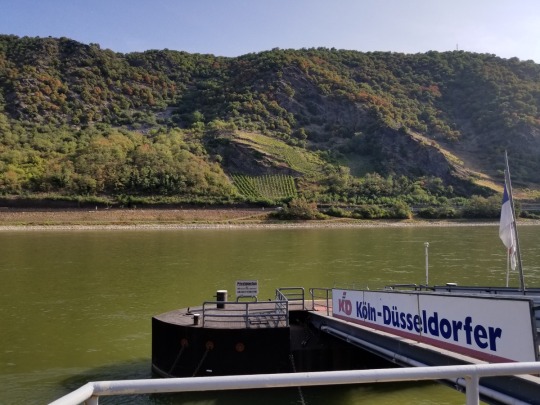
A cruise along the Rhine is an absolute must-do for anyone visiting the area. It proved a bit more complicated that we had anticipated, however, and we probably would have had an even better time if we had a bit more sense what we were getting into.
Ferries go up and down the river all day, but it's a long ride with a tight and complex timetable. Trying to figure out which tickets to buy was also a bit of a head-scratcher. You can get a hop-on-hop-off type ticket, but it's expensive and there aren't enough boats that you can take much advantage.
After puzzling it over between ourselves, Jessica and I eventually just decided to ask the ladies at the KD Rhine ticket counter what we should do. The first thing we should have done was to just go up and ask them in the first place, since they were able to sort us out very quickly.
Our plan was to start in Oberwesel, ride north downriver to Koblenz--a medium-sized city at the confluence of the Rhine and Mosel rivers--stop for lunch, then ride back upstream past Oberwesel to the popular tourist town of Bacharach. After exploring to our hearts' content, we would catch a quick train back home to Oberwesel.
After a couple minutes explaining this to the ticket ladies, they recommended a round-trip ticket from Bacharach to Koblenz as the most economical option.
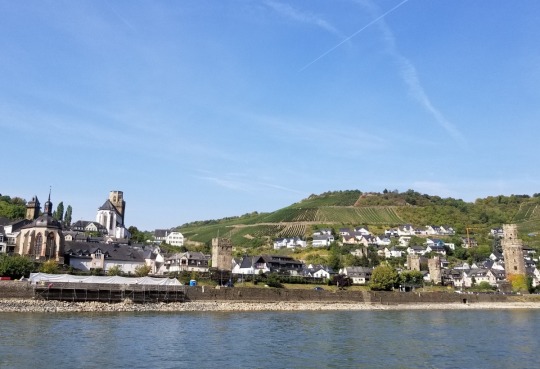
Finally, our boat arrived and it was time to board. We were a little nervous when we first boarded. Far from the luxuriously lazy experience I was expecting, the boat was packed shoulder-to-shoulder with tourists and nowhere to sit down. There was also no wifi onboard, contrary to the cruise company’s advertisements. We had been hoping to get some work done on the return ride, but if the crowds stayed the same, that wouldn’t be an option anyway.
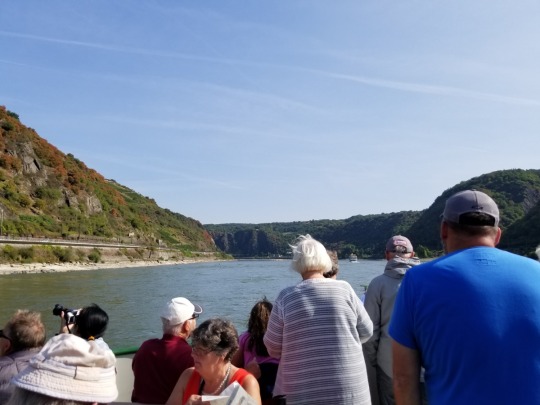
More concerning was the lack of any food service onboard–also contrary to the advertisements.
At one of the next stops, however, a large group disembarked, and there was room for us to sit down, for Jessica to take a Dramamine, and for both of us to just enjoy the ride. A huge chunk of the tourists who got off were Japanese. Apparently, one of the castles is privately owned by a Japanese businessman, and the nearby town of St. Goarshausen has become an object of fascination among Japanese tourists.
It's funny how different places become tourist destinations for different cultures. I'm sure Heidelburg would not have become a mecca for American tourists were it not for the American GI’s stationed there after WWII.
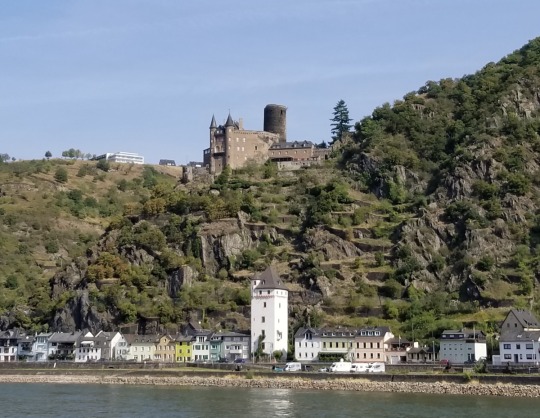
The Japanese castle is called Burg Katz, which means Cat Castle. Close by stands the rival Mouse Castle. And across the river from Burg Katz is the massive Rheinfels Castle in St. Goar, which Burg Katz was built to supplement. Between the two of them, the owners could command an entire stretch of the Rhine.
Because that's what all of these castles were built to do.
As we've learned so thoroughly, Germany spent the vast majority of its history as a constellation of semi-independent states that were allied more in theory than in practice. Local lords had free reign to raise money and fight for their own interests in pretty much any way they saw fit.
The Rhine was one of the busiest trade routes of them all, and everyone wanted a taste. Castles were erected every few miles, and sometimes much closer. Not for war or defense, but for toll collecting. Any trader wishing to raft their goods downstream would need cash for dozens of tolls along the way.
Most of those castles fell into ruin or were destroyed during various border wars with France, but a good handful have survived or been rebuilt by wealthy enthusiasts.
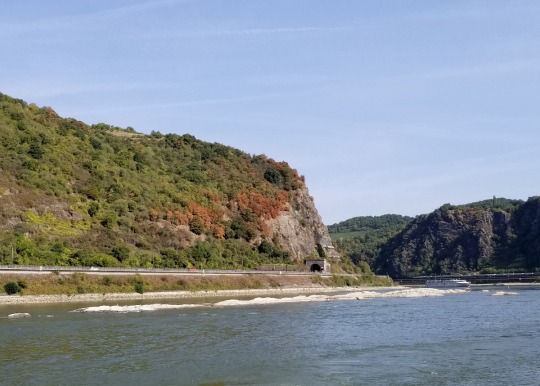
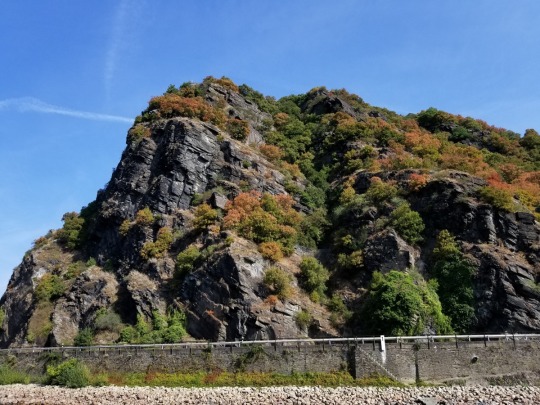
Nature provided its own set of obstacles as well. As idyllic as the sleepy valley seems to us, parts of it were a menace to sailors. Just downriver of Oberwesel lies a cluster of deadly reefs known as the Seven Sisters, followed by a narrow hairpin turn in the shadow of a massive, echoing cliffside known as the Loreley (a sort of Germanic equivalent to the mythological Green sirens). Simply making it the few miles from Oberwesel to St. Goar could be a day-long endeavor and would certainly merit an evening's celebration.
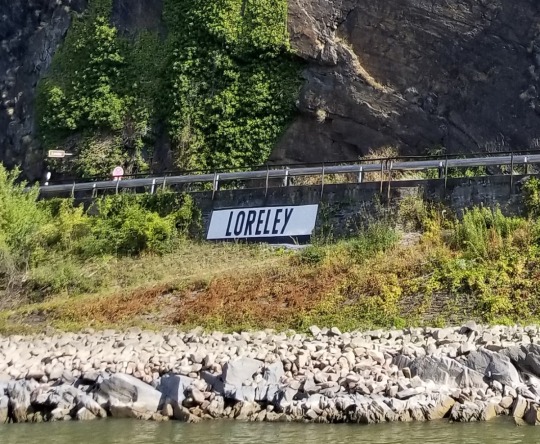
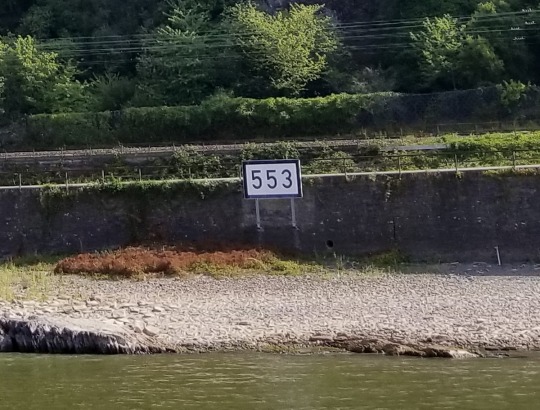
High-contrast signs and kilometer markers posted along the banks of the river make it easy to follow along in a guidebook.
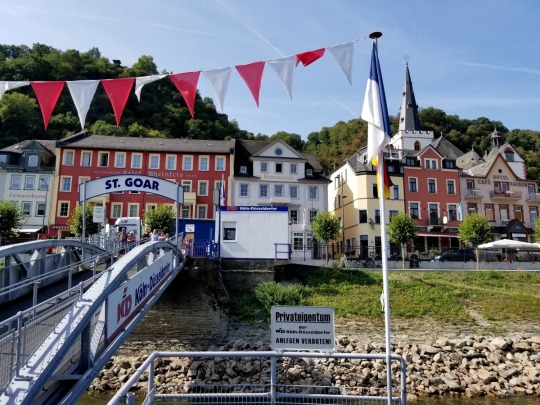
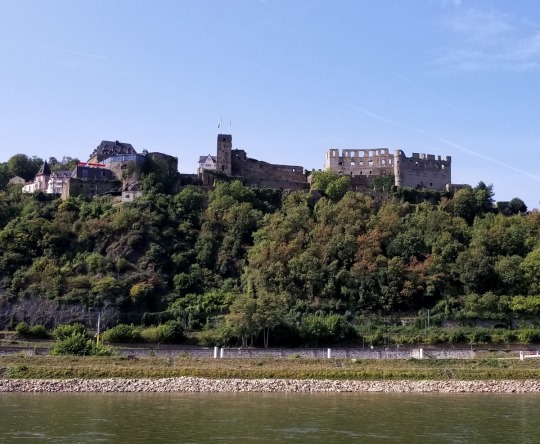
Above St. Goar looms the aforementioned Rheinfels Castle. Now a hollow ruin, it was once one of the mightiest castles in the entire Holy Roman Empire--a bastion of vigilance against the threat of French invasion.
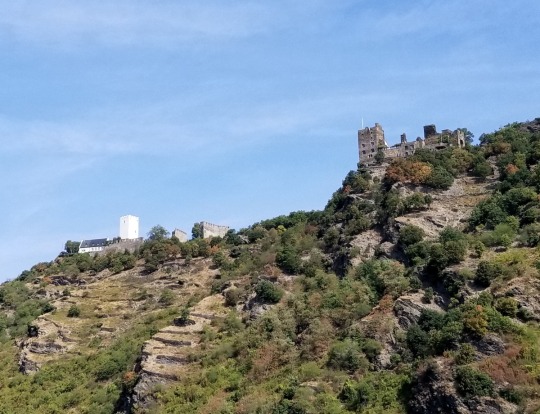
Further downriver stand the twin castles of Sterrenberg and Liebenstein, joined together by a long defensive wall.
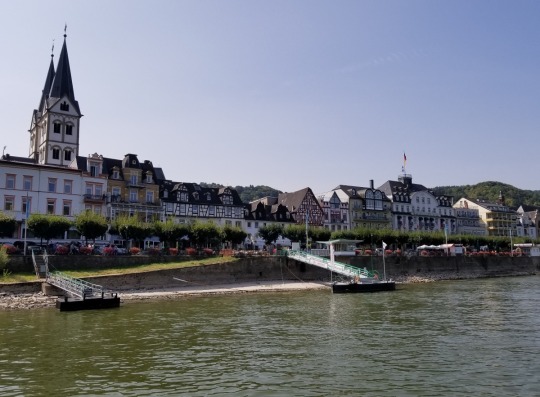
Even further downriver are the charming town of Boppard--where we had originally considered staying--and the brilliantly whitewashed Marksburg Castle--possibly the best-looking of all the Rhine castles.
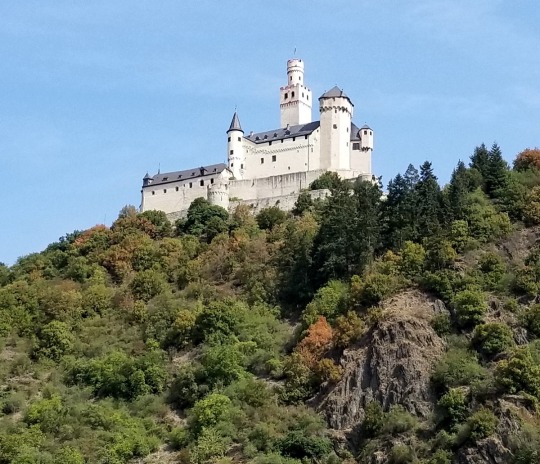
Marksburg was never destroyed, and it has been restored to look more or less like it would have back in the days of the Holy Roman Empire.
Learned from Rick Steves that there are two German words for "castle," each with its own meaning. A burg is a functional castle like pretty much all of the castles on the Rhine once were, whereas a schloss is luxurious castle used primarily as a prestigious residence, like Neuschwanstein and Hohenschwangau back in Bavaria.
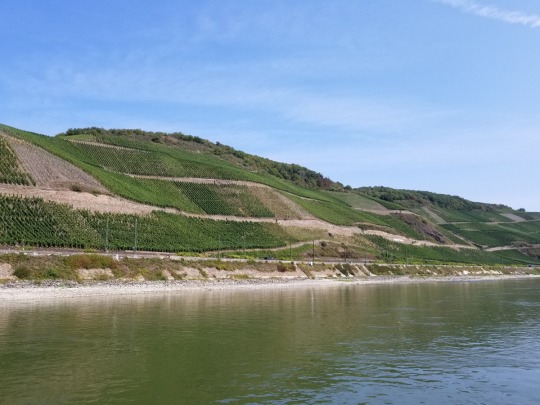
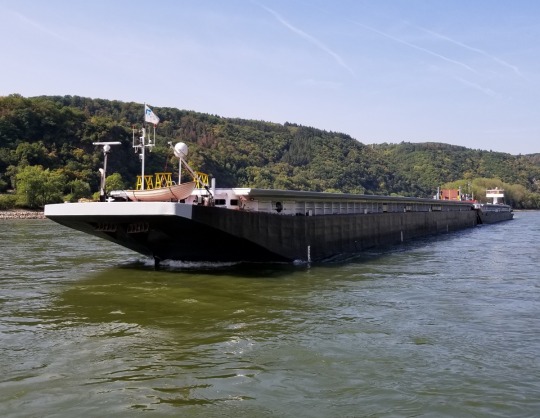
The last stretch of the Rhine is mostly filled with long lonely vineyards and a constant stream of commercial barges going past in both directions. Even in the age of trains, planes, and ultramax cargo ships, the humble river barge remains a mainstay of European trade.
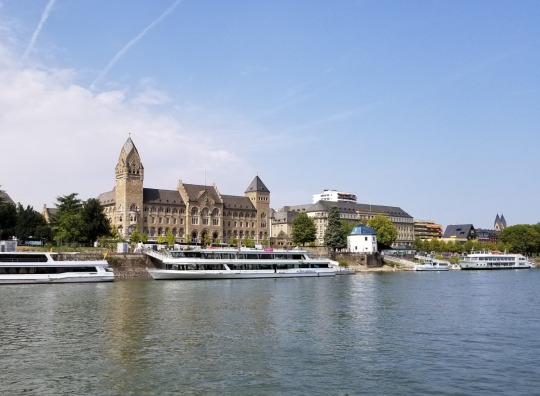
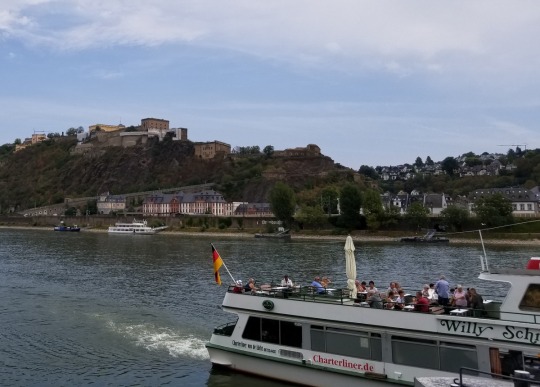
Finally, we arrived in Koblenz. It seems like a nice city, but we were hungry and in a hurry. Since there hadn't been any food on board, getting something to eat was top priority. Moreover, our boat was behind schedule, so we had just 30 minutes to get off the boat, find something to eat, eat it, and get back on the boat with enough time left to get a good seat.
The closest fast food or grocery store we could find on our phones was over 10 minutes’ walk each way, so we ended up just grabbing a bratwurst from a nearby stand, scarfing it down, and getting back onto the boat. Luckily for me, we had brought some meal bars just in case.
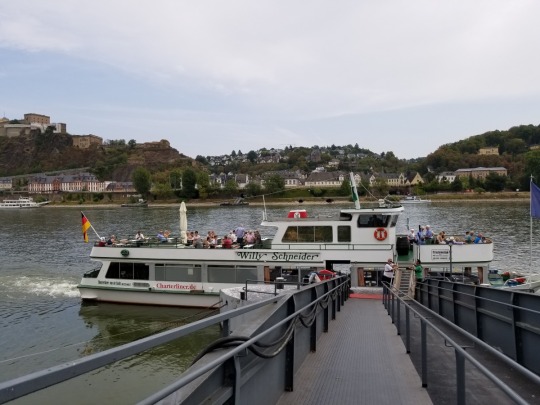
We decided to enjoy the upstream journey below-decks, where we could enjoy some comfortable seats, cold beers, and a table to set up our laptops and get a bit of planning done.
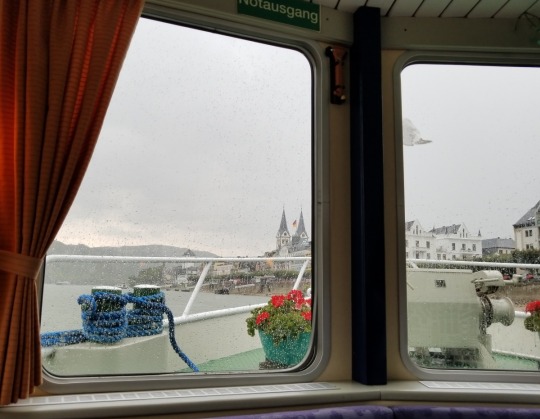
About halfway back, though, it started to rain–driving everyone above-deck down below. Then we picked up a huge crowd of people from one of the towns. Our quiet, comfy booth soon became a crowded, stuffy, and painfully noisy confinement. I must admit that the pressure of all the planning, moving, and sightseeing we'd been doing hit me especially hard that day, and that hour in particular was not my happiest. At least the beer helped once I finally broke down and ordered one, too.
The rain had mostly died down by the time we were nearing Oberwesel, so I went back above-decks to get some views and fresh air.
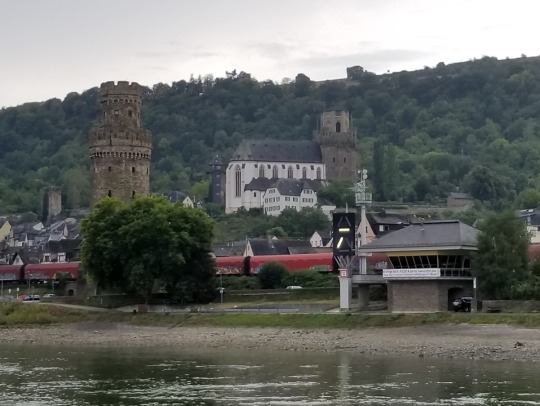
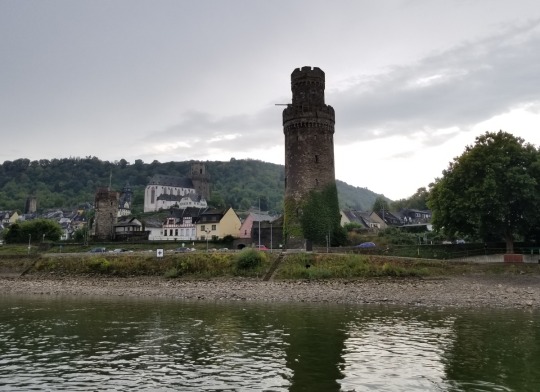
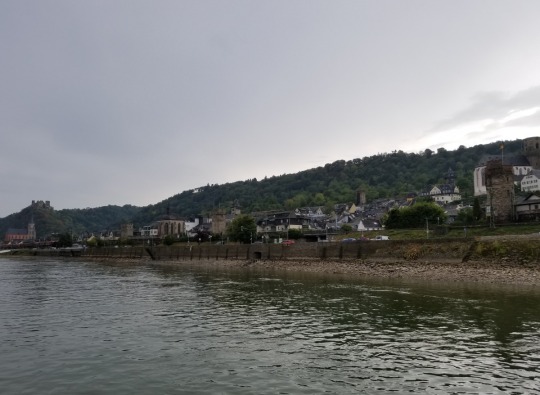
But remember, we weren't done yet. We'd be heading a few stops further upriver.
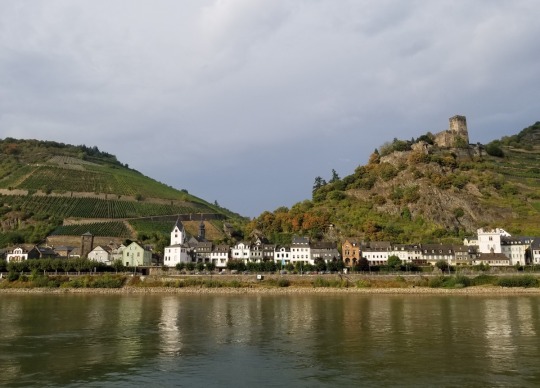
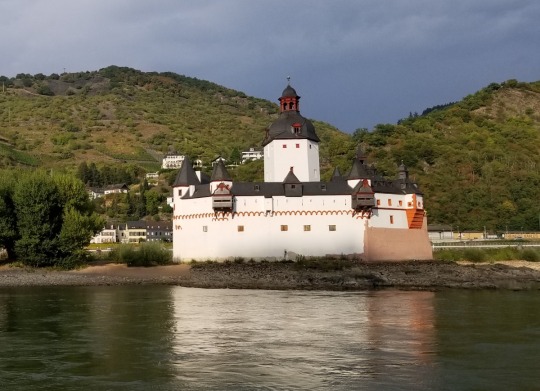
Just upriver from Oberwesel lies the painfully postcard-perfect town of Kaub. On the hillside nearby stands Gutenfels Castle, while its sister Pfalz Castle sits right in the river--the ideal spot for collecting tolls.
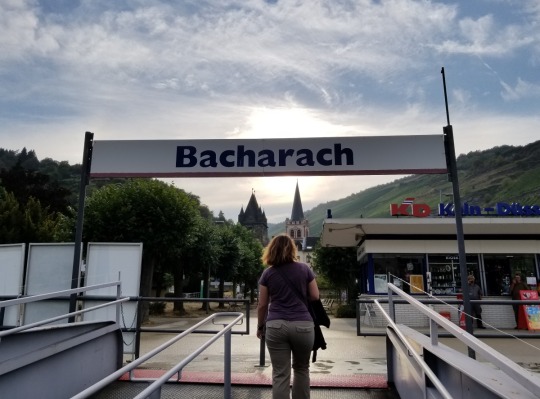
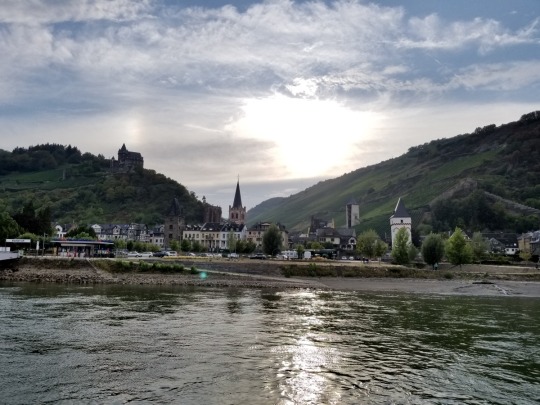
Finally, with the lowering sun piercing the clouds like a spotlight, we arrived at our final stop--Bacharach, a winemaking town named after the god of wine Bacchus himself.
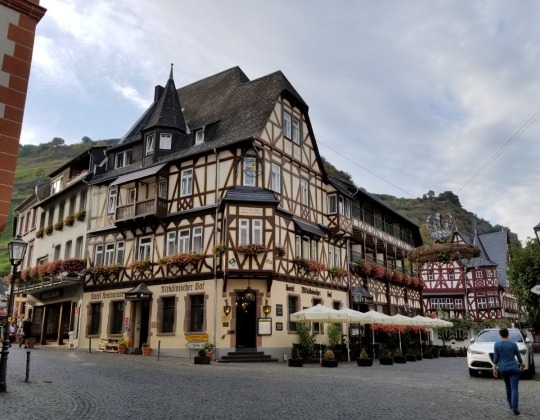
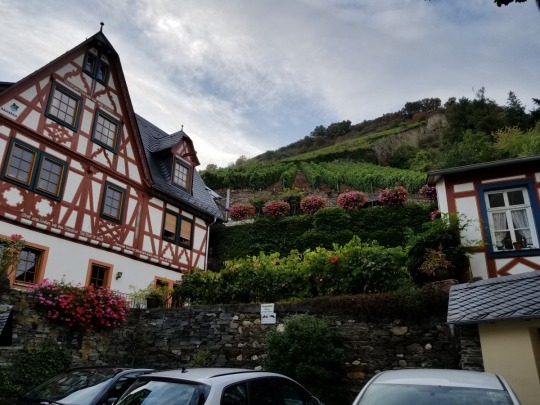
Bacharach is Rick Steves’ top recommended place for staying on the Rhine, and after visiting it we can see why. It’s not as big as Oberwesel or dramatic as St. Goar, but its sweeping hillsides, cobbled streets, and half-timbered houses are a photographer’s delight. Seriously, if we had an extra day I’d be tempted to come back and spend it all just taking pictures.
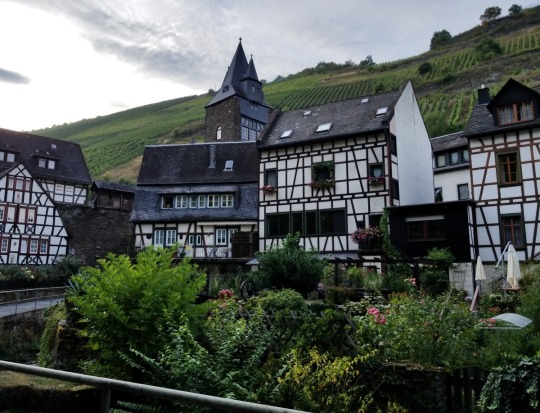
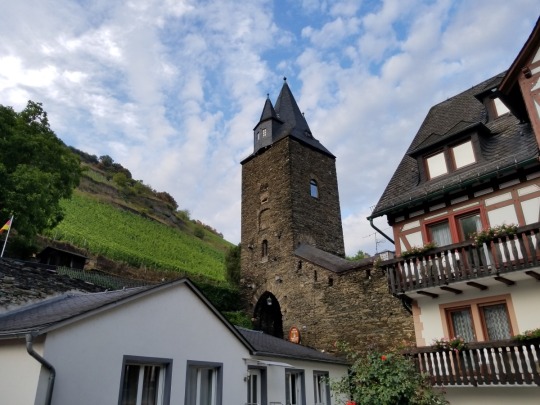
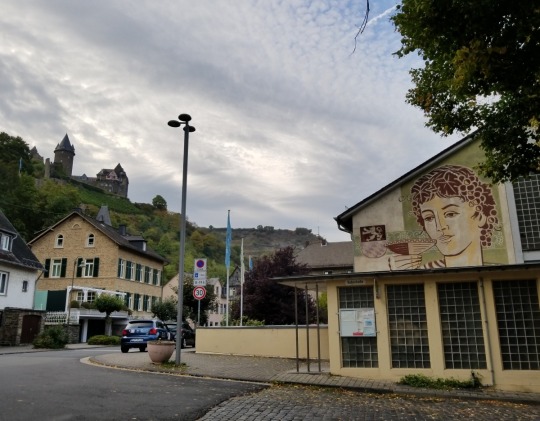
Finally, we caught the train back to Oberwesel, arriving home tired and hungry but satisfied with the day’s adventure.
—
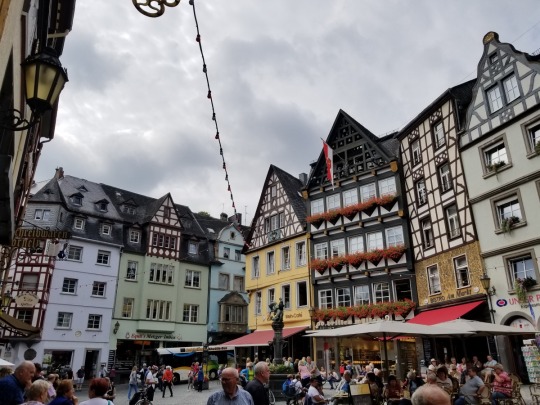
We spent the next day taking a trip to Cochem, a small town on the Mosel river known for its charming medieval architecture and abundance of wine shops. There was no question that Jessica and I had to go for ourselves. Things didn't all go quite as expected, that just meant that we got to learn a lot we didn't know about German wine tasting culture. It was a fun day, and we'll cover it in it's own post, too.
—
We had originally planned to spend the next day visiting St. Goar and Rheinfels Castle, but instead we decided to stay home and relax.
Well, we stayed home, but we didn’t do very much relaxing.
We decided to do some planning for our upcoming stay in Amsterdam, the penultimate destination of our trip. We hashed out our itinerary easily enough, but when it came to planning our transit strategy, things got very frustrating very quickly.
Public transit in Amsterdam is very easy and reasonably affordable, as long as you’re staying inside the city limits. We weren't staying that far outside the city center, but apparently it was enough to put us into a different municipality. Most major cities have transit cards or passes that you can buy and use to get cheap access to local transit and commuter trains. In Amsterdam, however, you can only get one of these cards if you're a resident. Rather than being able to use a discount transit pass like we had in many other European cities, we'd need to buy two sets of full-price tickets for every day we went into the city--one for the commuter train and one for the city transit system.
Lesson learned: If you're going to try and save money by being clever, make sure that you are actually being as clever as you think you are.
In the end, we at least managed to find a smartphone app by the Dutch rail system that would let us buy our tickets digitally--something that would prove far more important than we could have anticipated.
Anyway, all of that proved to be a headache that consumed much of our day.
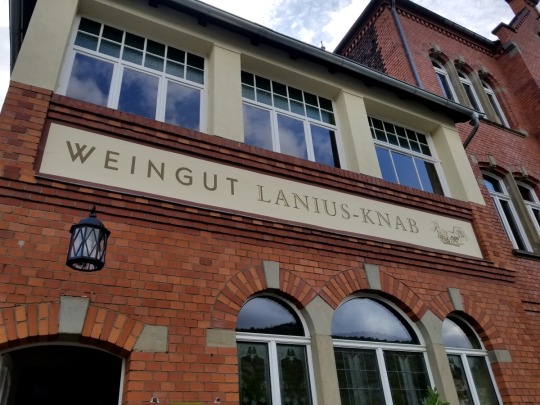
Things got better that evening, when we went to a wine tasting and cellar tour at a local winery called Lanius-Knabb. We'd heard about the place when we were first researching Oberwesel, and when we visited the TI a few days earlier, they offered to call the place up and let them know we were coming.
We showed up right on time, but the owner didn't seem to have been expecting us. He let us in, however, and we joined a German couple who were already a couple glasses into the tasting. Perhaps the information in the TI brochure was out of date, or maybe Rhine time is just a bit like island time that way.
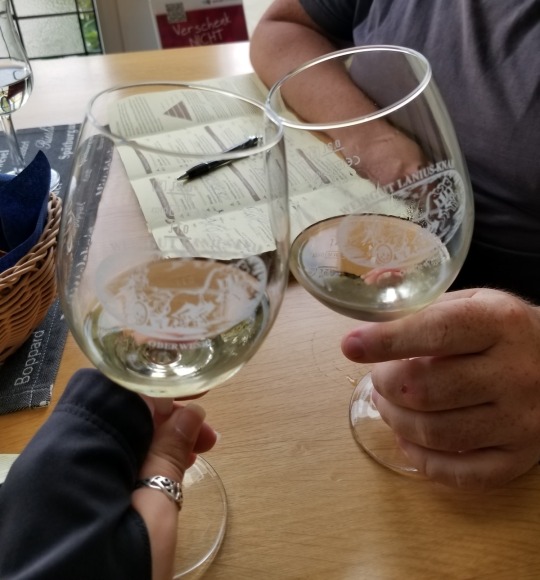
In any case, we had a great time. The German couple didn't speak much English, but their English was still far better than our German. They seemed very nice, and we learned they were from the town of Nürburg (not to be confused with Nuremberg, which is on the opposite side of the country).
Our first two wines were Pinot Noirs--one red and one white. They were interesting, but not particularly enjoyable (at least to me). The red tasted tight and sour, while the white seemed flat and a little boring. Jessica liked the white better, since it was a bit like an unoaked Chardonnay.
Next came the dry Rieslings, which were spectacular.
Their standard estate wine was light and fruity, with light and refreshing fruity flavors that sparkle and dance on the tongue.
The second Riesling--which they called their "Premier Cru"--was even better. It didn’t dance, but it had a more powerful and cohesive flavor profile.
The third Riesling–which they called their "Grand Cru"–blew everything else away. It was rich, fruity, tart, powerful, and refreshing all at once. And the owner of the winery (who was the one giving the tasting) said that it was still too young to really appreciate. Basic Rieslings should be drunk within a year or two, but he said that this one could be cellared for around ten years before it hits its prime.
This third Riesling was made exclusively with grapes from their Oelsberg vineyard--a distinctive sideways "Y" on the slopes just north of town. We'd seen it plenty of times by then and recognized its picture instantly.
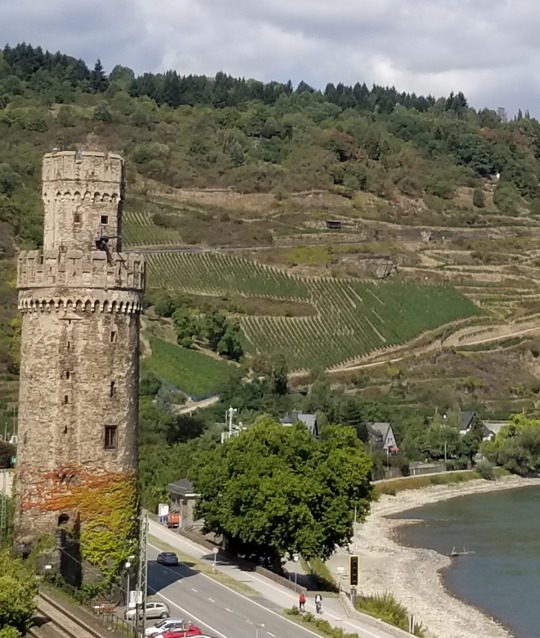
We then moved on to the sweeter Rieslings, with one half-dry, one sweet, and one late harvest (very sweet). I liked them all, but the last two were too sweet for Jessica's taste. She did still appreciate them, though, comparing them favorably to some California dessert wines that failed to reach the same level of balance and delicacy as these Rieslings.
While we were enjoying our tasting, a bit of travel stress managed to force its way back in. Halfway through, our phones buzzed to inform us that our Airbnb host for Iceland had just cancelled our reservation.
Great.
But we couldn’t do anything about it then, so we resolved not to worry about it. It also gave us an excuse to stay in town the following day as well so that we could sort everything out.
After the tasting was finished, we bought two bottles of the Oelsberg Riesling, saddened to learn that the winery doesn't ship to the US. As we'd come to expect, our German friends bought far more wine. Then, unexpectedly, they left. Which left us to enjoy a 1-on-2 tour of the cellar with the owner.


Now, you might have already noticed something a bit strange. Every other time we've done a wine tasting with a cellar tour--at home or in Europe--the cellar tour always came before the tasting. And that seems like a very sensible idea, considering all the stairs, dark corridors, and industrial equipment that one has to traverse along the way.
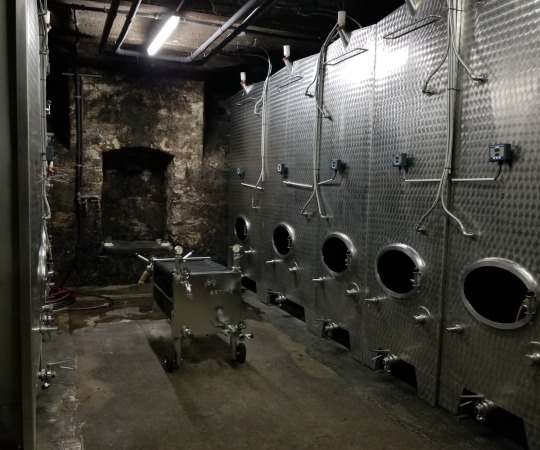
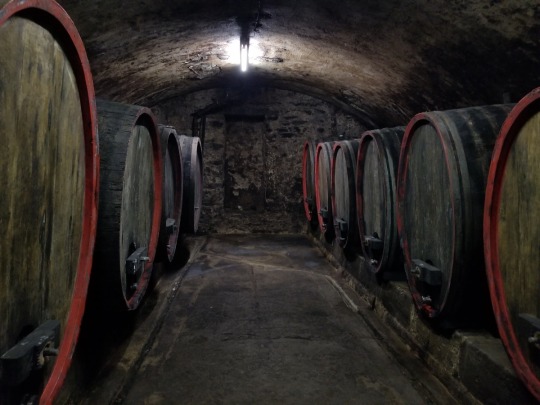
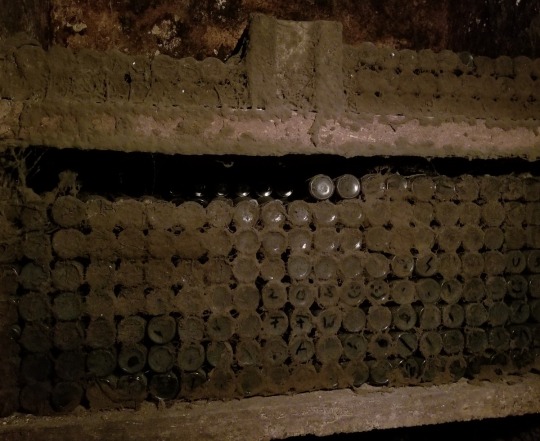
We made it through just fine, however, and we had a good time listing to the owner. He told us about his passion for winemaking and the story of how he grew the estate from one small vineyard to a relatively large operation over the past twenty-something years.
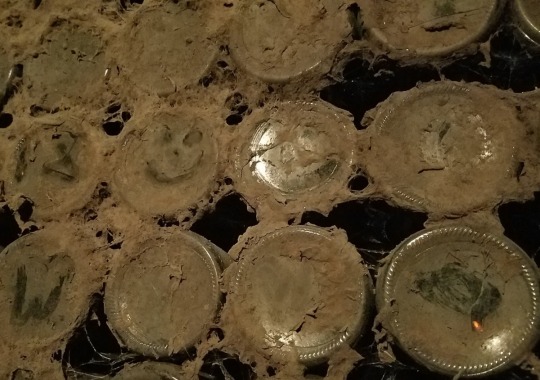
Jessica particularly appreciated how the cellar reminded us of the ones we saw in Burgundy, filled with natural dust and molds. In the States, everything is sterile. Which isn’t to say that cleanliness is a bad thing, but sterility also means lifeless. And when it comes to things like wine or beer or even milk, cheese, and bread, food is alive. Sterile food is dead food. And it just doesn’t taste as good.
Thoroughly pleased and beginning to sober, we made our way home and enjoyed a nice, simple dinner–with a bottle of wine, of course.
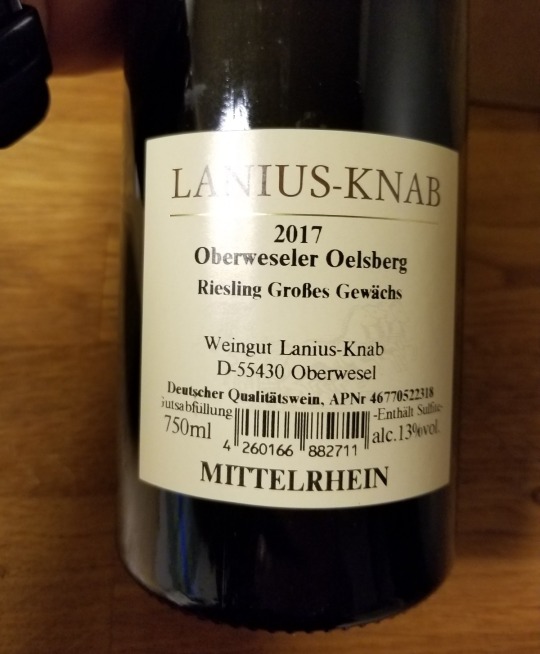
Such a good wine…
—
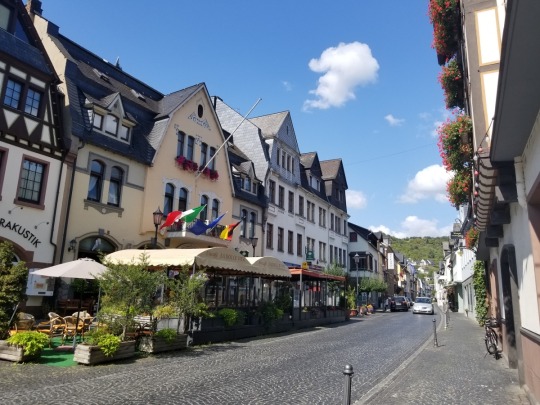
On our last day in Oberwesel--time flies!--we slept in, made a nice big breakfast, and sorted out the Iceland situation. We were able to find a very nice place that was only a bit more expensive than our original place, and we booked it.
We later learned that our original host had to cancel all of her bookings because of an emergency situation that had rendered their home uninhabitable. We made sure to tell them not to worry about us and that we hoped their situation improved soon.
While we hadn't done nearly as much sightseeing as I had originally hoped, I at least wanted see more of Oberwesel itself. Luckily, our Rick Steves guidebook had a great walk mapped out for us, starting at the market square.
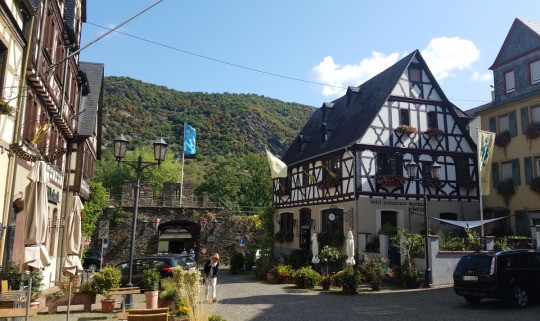
Like many towns along the Rhine, Oberwesel started as a Celtic settlement in pre-Roman times. After the Romans displaced the Celts from the European mainland, it became a Roman military base, and then a rest stop for Medieval loggers and traders moving their products downriver.
Today, the Rhine is as economically important as ever, but the diesel-powered barges no longer need to stop for a rest every few miles. The towns of the region are struggling to maintain their relevance and identity through winegrowing and tourism, but it's an uphill battle. The streets are all but abandoned on most days, and many of the vineyards lining the river valley have been left untended in the hope that future generations will have the will and resources to reclaim them.
In a way, it reminds me of all the small, struggling towns you might pass through on the old US Route 66, or any other bypassed backroads.
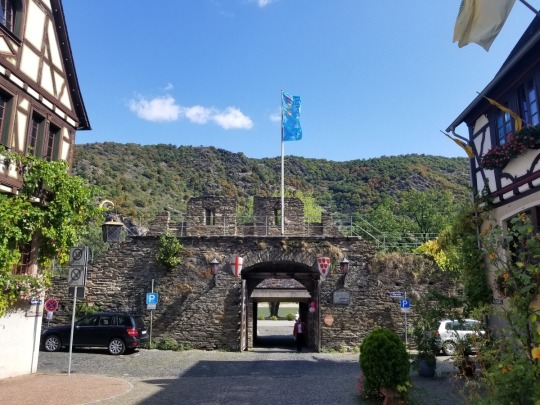
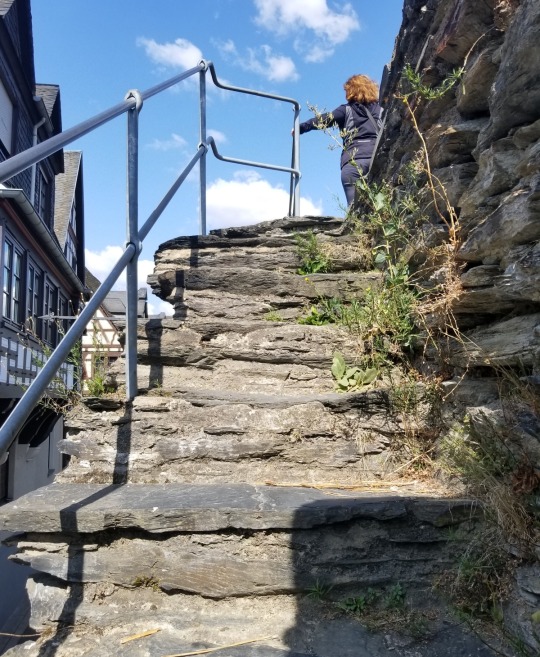
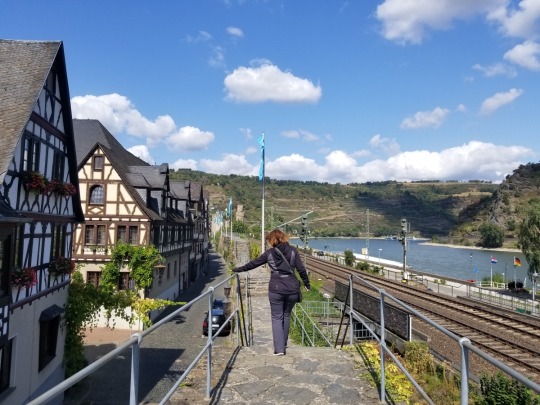
The main attraction of Oberwesel in particular is its exceptionally well-maintained medieval wall and its many surviving watchtowers--each of which has its own distinctive character.
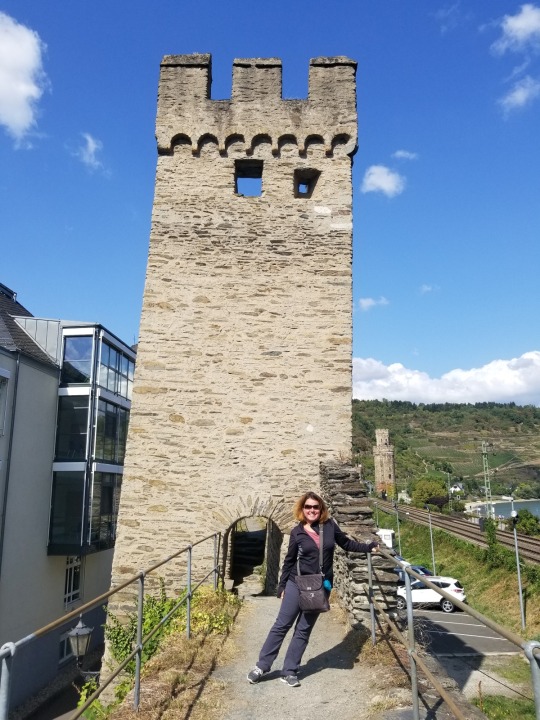
The Hospital Tower--named for its proximity to the town's medieval hospital--was built too heavy for its foundations and started to lean over like the Tower of Pisa. Rather than start over, the builders simply lopped off the top at an angle to make the roof level.
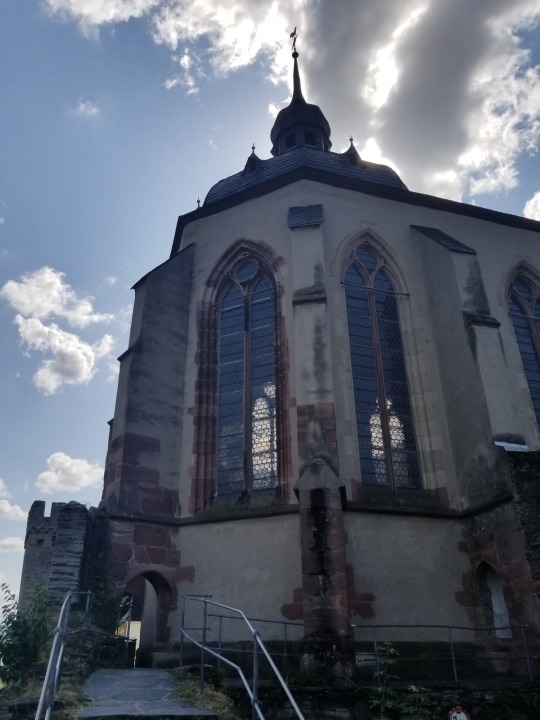
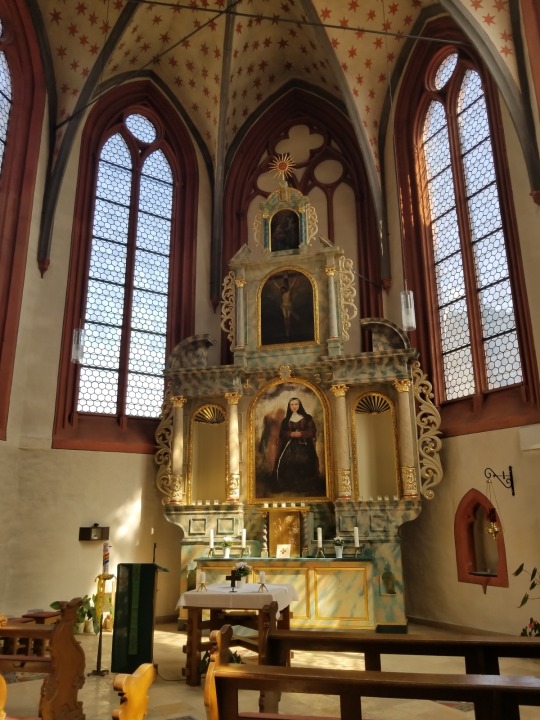
A little further down is the chapel of the medieval hospital, which is built directly into the walls--perhaps so that the guardsmen of the town could pop in for a quick prayer while on their rounds.
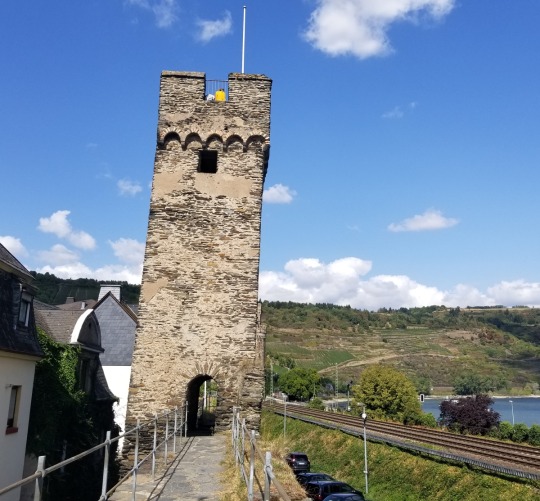
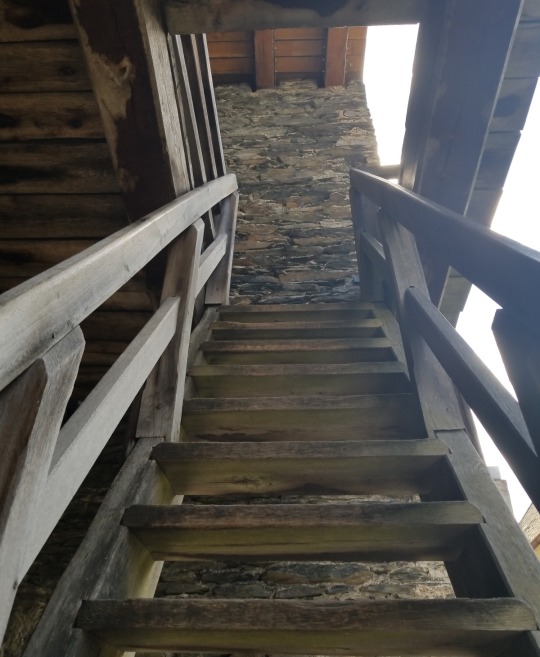
Next is the Stein Tower, named for the town's first paved road. It has a similar canter to the Hospital Tower, but this one is climbable. Steep wooden stairs carried us up to the top, where we enjoyed an absolutely spectacular view.
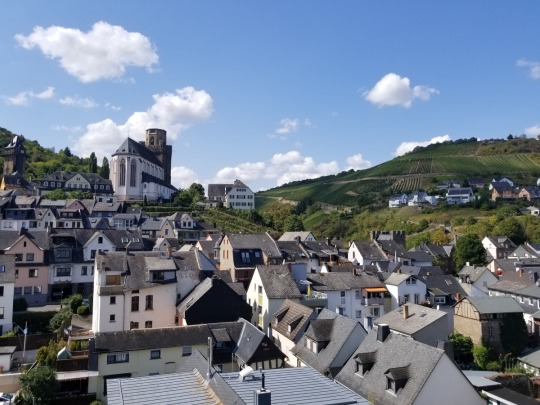
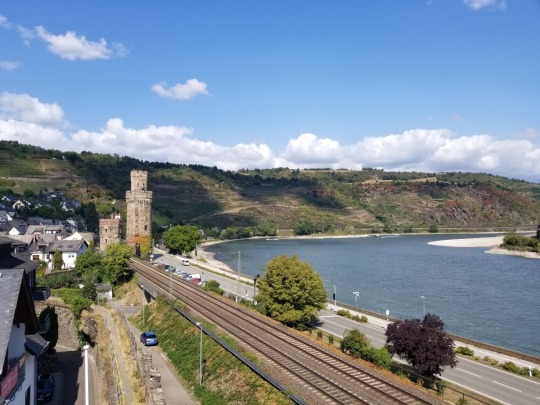
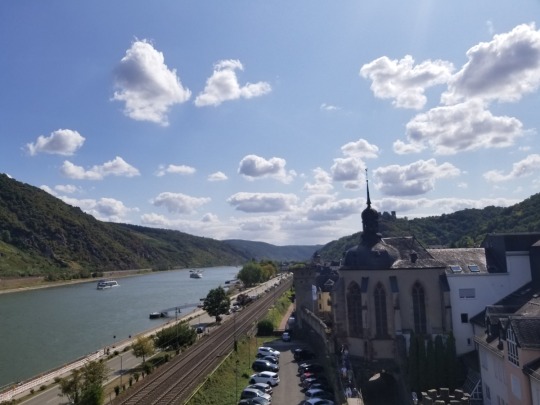
Apparently, this very spot was enjoyed by some of the most famous Romantic writers and painters of the 19th century, including Victor Hugo.
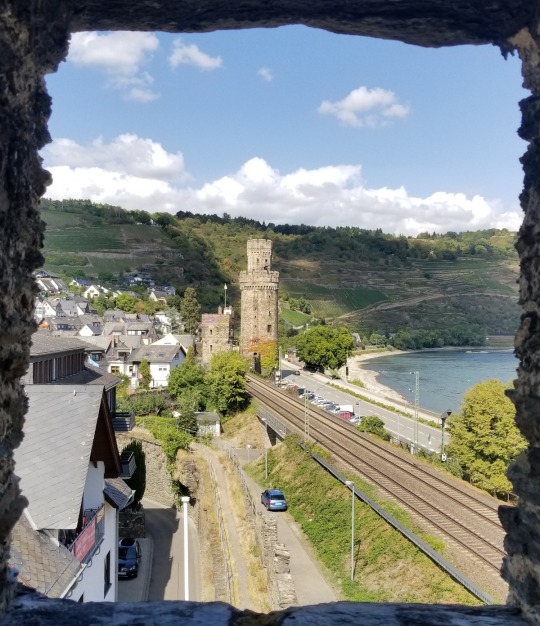
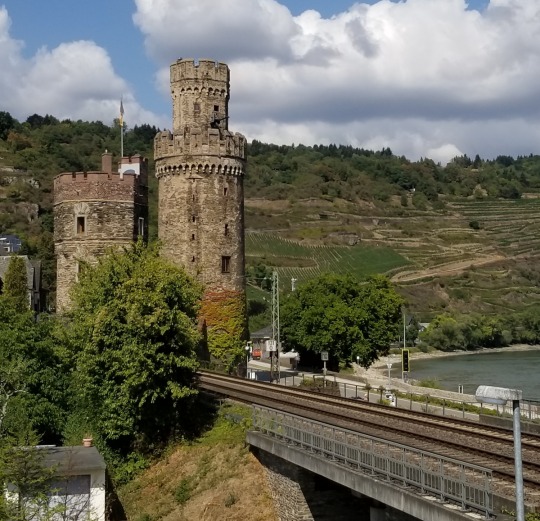
Further downriver stand the beautiful and now-inaccessible Cat and Ox towers, which marked the northwestern corner of the town.
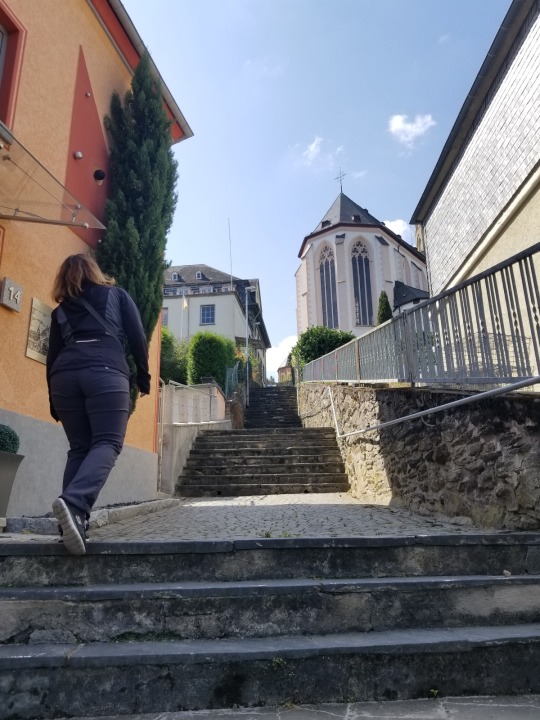
Having reached the end of this stretch of wall, we climbed down from the wall and climbed up to St. Martin's, the big white church overlooking the northern end of town.
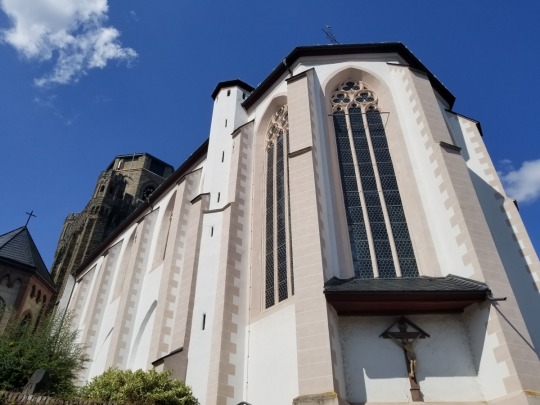
Much like Frankfurt Cathedral (which we'd already seen but will cover in the next post), St. Martin's was built from cheap local stone, then plastered over and given a clever paint job to look like it was made with more exotic foreign stones. It's ironic and a bit telling of the human condition that wealthy people in slate-rich places showed off by building in limestone, while wealthy people in limestone-rich places showed off by building in slate.
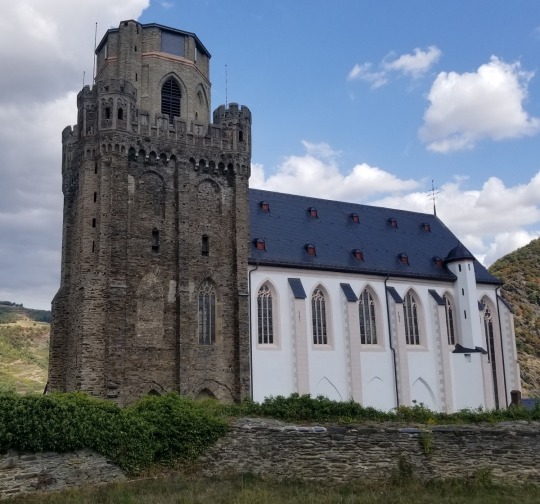
The church's bell tower actually predates the rest of the church. It was originally a watchtower along the town wall, and the locals decided to convert it into a belltower and build the rest of the church out from it.
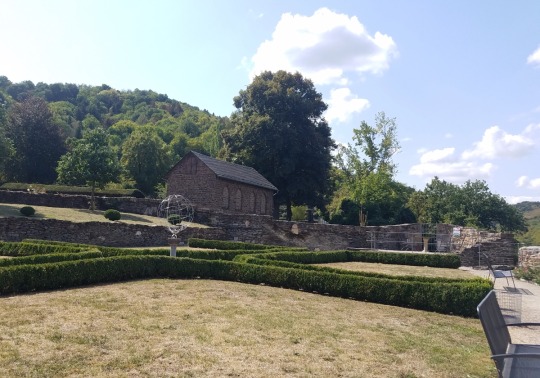
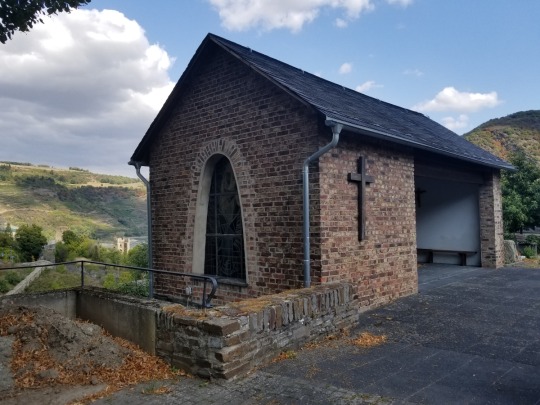
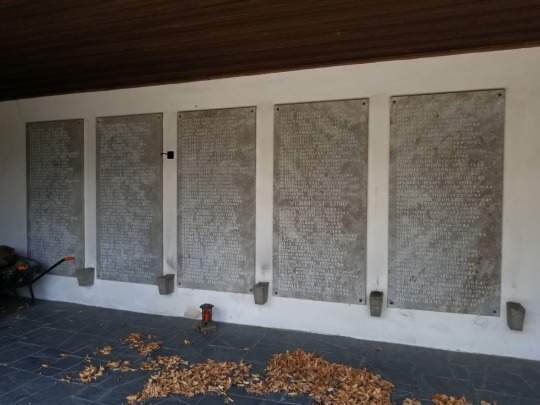
Around the back of the church is a peaceful community garden and a secluded cemetery with a chapel dedicated to the local men and boys who died during WWII.
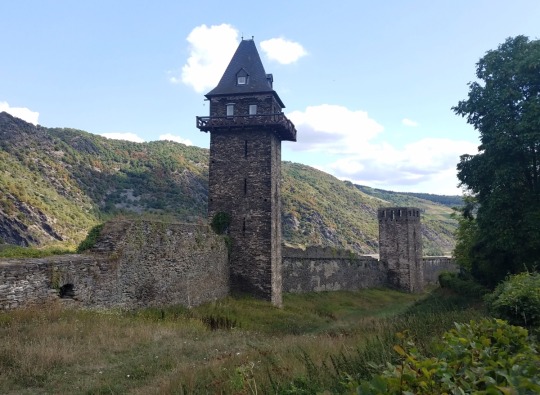
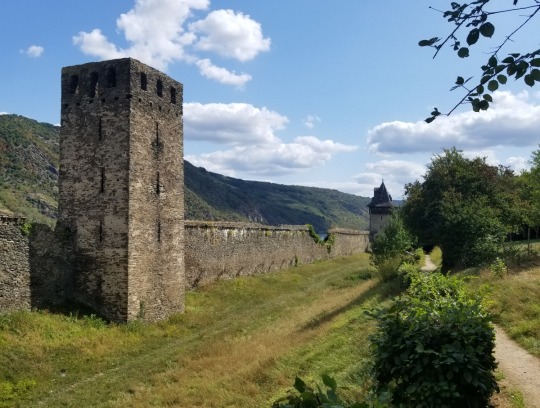
That left the western town walls. We couldn't walk on top of them, but there is a little hiking path that runs just outside of them. Apparently, the town allows people to lease the old watchtowers and turn them into houses–as long as the buyers agree to restore and maintain the tower with their own money. One of these converted residential towers even has its own drawbridge.
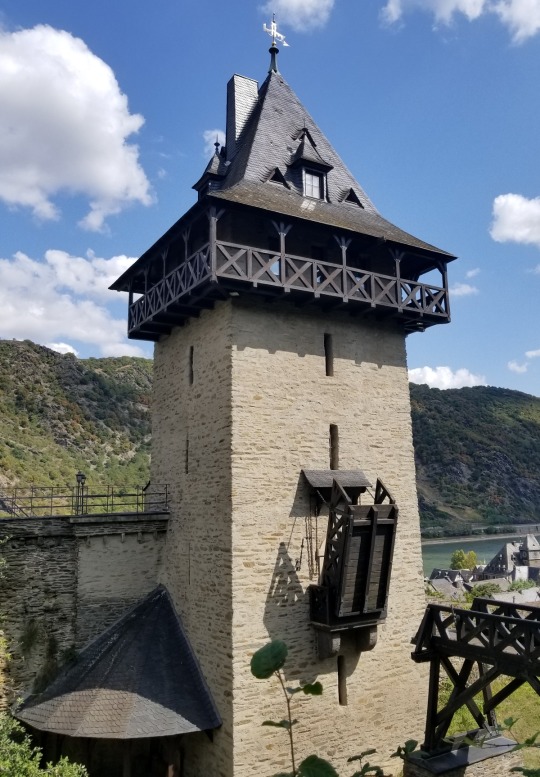
According to Rick Steves, there is a local legend about its owner's then-teenage son. When his parents were away, he threw a big party. Locals complained about the noise, and the cops showed up. Unintimidated, the kids simply raised the drawbridge and kept on partying.
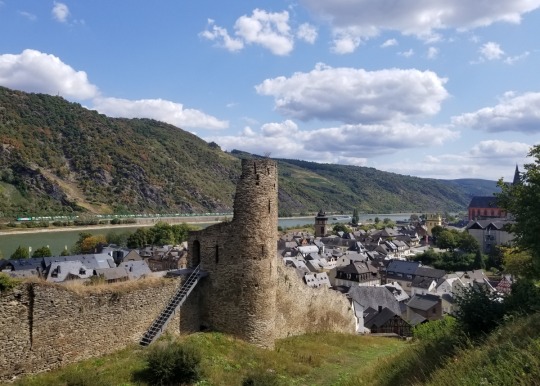
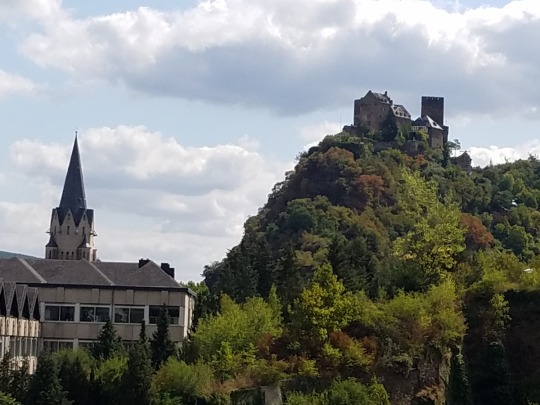
From there, it was a short walk to the end of the western walls, with some great views of the southern part of the town and the castle overlooking it all.
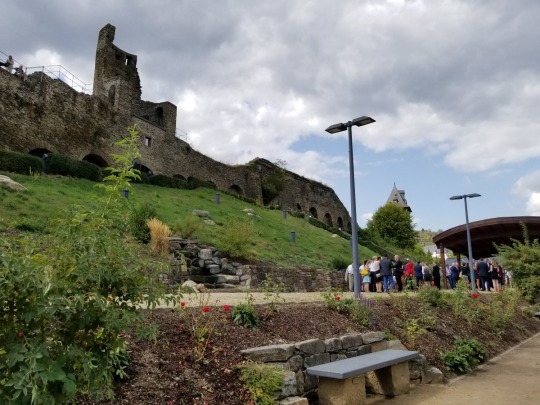
Back inside the old town, we peeked into a lovely little park where they shine lights up on the walls at night. There was a wedding reception going on, however, so we didn’t linger.
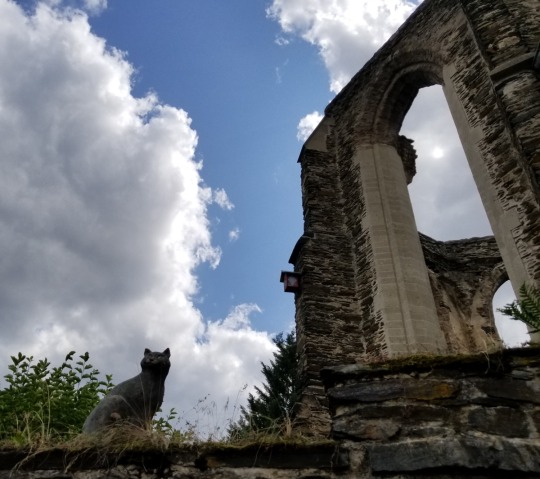
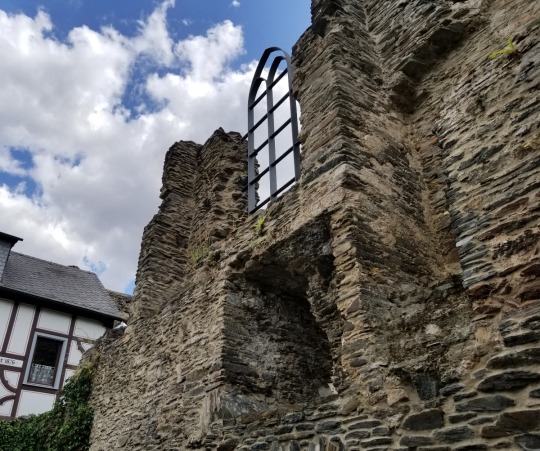
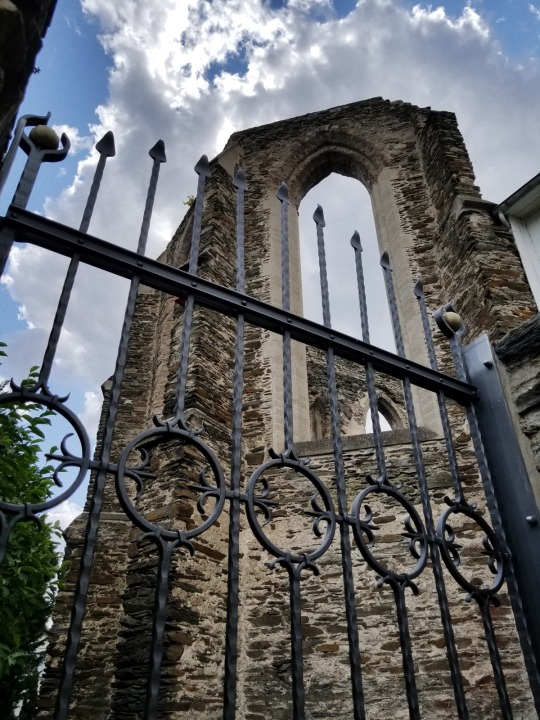
The last stop on the Rick Steves tour was the old Franciscan abbey. It was dissolved by Napoleon in the early 1800s and burned down shortly afterwards. But a couple generations later, when the local economy was suffering, desperate locals started moving into the ruins and setting up makeshift homes inside them. Local authorities have done some restoration work to expose the old abbey ruins, but the houses still stand and remain occupied to this day.
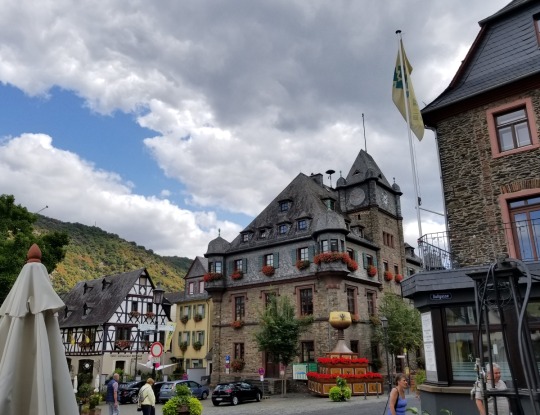
Satisfied with our day's walk, we made one last trip to the grocery store and headed home for relaxing afternoon before packing up. We didn’t get to do everything we had planned on doing in the Rhineland, but we had a great time with what we did. The Rhine isn't necessarily at the top of my list of places to visit again--unless as part of a wine tour--but I would still happily visit it again. It definitely feels like the sort of place where it's important to visit on the right days and with the right expectations.
Tomorrow, we would be heading to the Belgian coastal city of Bruges.
#180abroad#oberwesel#rhineland#germany#travel#castles#river cruise#koblenz#bacharach#cochem#wine#riesling#even travelers need days off
1 note
·
View note
Quote
Are you an Iowa State fan traveling to Memphis for the 59th Annual AutoZone Liberty Bowl? Or an out of town Tigers fan coming home for the game? This post has most everything you need to know about where to stay and what to do in Memphis. I promise, I really did try to keep it as short and sweet as possible… You can also check out the Memphis Cheat Sheet that has some of the same info, but with more descriptions and insider tips. Also, Sports Illustrated ranks this year’s Liberty Bowl #2 on its list of most entertaining bowl games. Boom. Click to view slideshow. The Game The Liberty Bowl game between Iowa State and University of Memphis is Saturday, December 30 with an 11:30 a.m. kickoff. Park at the stadium or take and Uber/Lyft/cab. The Memphis cab number is 901-577-7777. The Liberty Bowl has a clear bag policy and they will be enforcing it! You can’t bring bags unless they’re clear or tiny. Read more. Where To Stay If it were me, I’d stay in a hotel downtown or snag an Airbnb in the midtown area (Cooper Young, Overton Square, Liberty Bowl area). There are also plenty of hotels in East Memphis. Downtown, you can walk to Beale Street and the river and other stuff to do. It’s about a 10-15 drive to the stadium from there. In East Memphis, you might need short rides to get to restaurants, but it’s still just a 15-20 minute drive to the stadium. Click here for info on local hotels. Other Liberty Bowl Tips Get more details on tailgating, parking, game day tips here. There are other Liberty Bowl events. You can get tickets to the team welcome party, a pro rodeo, a lunch with players and coaches, or a gala. Or, you can go to the free, non-ticketed Liberty Bowl Parade on Beale Street on Friday, December 29 at 3 p.m. There’s a pep rally afterward in Handy Park (on Beale) at 4:30 p.m. If you’re not tailgating at the Liberty Bowl (we call that area Tiger Lane), then a few nearby bars are opening at 10 a.m. that day. Five Things You Must Do In Memphis 1. Music History Pilgrimage Visit Graceland, obviously, if you have the time and money. Other fun music museums/tours are Stax Museum of American Soul Music, Rock ‘n’ Soul Museum, and Sun Studio. 2. Eat BBQ Locals love Central BBQ, Cozy Corner, Tops, Payne’s, Bar-B-Que Shop, One and Only, among many others. You’ll get mixed reviews from locals on tourist-friendly Rendezvous, but it’s certainly the most well-known spot. There’s a list of non-BBQ restaurants at the bottom of this post. 3. Walk/take short drives around Downtown. If you’re up for a few miles, you can see a lot in an afternoon/evening. See the river at Beale Street Landing/Tom Lee Park or walk across it at Big River Crossing. Visit the historic Peabody Hotel for food, drinks, and daily kid-friendly duck marches. Then, walk down historic Beale Street for live music, food, drinks, and some shopping. At night, Beale Street is a big party; hopefully you’ll see the flippers. If you want, take a picture in front of an I Love Memphis mural on the side of Wet Willy’s. You’ll be able to see FedExForum, home of the Memphis Grizzlies, even if they don’t have any games during Liberty Bowl Weekend. 4. Pick Some Attractions. Memphis has a ton of things to do. Pick one or stay an extra few days and do them all. – National Civil Rights Museum – Memphis Zoo (one of the top-rated in the country, we have pandas and a baby hippo) – Backbeat Tours (musical history on a bus, walking ghost tours) – Memphis Hop (hop on-hop off bus) – A Tour Of Possibilities (civil rights tour) – Bass Pro Pyramid (worth it for the sheer spectacle of the thing) – Shelby Farms Park For the Kids – Memphis Botanic Garden (has “My Big Backyard” playground) – Children’s Museum of Memphis – Pink Palace Museum 5. Nightlife If you want to party and enjoy some live music off of Beale Street, check out a few of the local watering holes and music bars. – Lafayette’s: spacious music room in Overton Square entertainment district – Hi-Tone: dive-ish but legit music bar – Bar DKDC: tiny snazzy venue for late shows – Our taprooms/breweries: Wiseacre, Memphis Made, High Cotton, Ghost River, Meddlesome Brewing – Hammer & Ale: serves all the local brews – Young Avenue Deli: open late and has pool – Earnestine & Hazel’s: famous dive bar with Soul Burgers served late – Celtic Crossing Irish: pub/weekend brunch by day, chill club by night – Bardog Tavern: awesome pub grub, late night bar (smoking) – Railgarten: outdoor millennial hotspot with live music, big crowds – SOB: good drinks and late-ish food OK, if you need more food recs beyond BBQ, here ya go. Read up on any of the places that sound interesting to you, the breakfast spots especially tend to get crowded. Breakfast: – Blue Plate Cafe – Sunrise Memphis – The Liquor Store – Brother Juniper’s – Tamp & Tap – Gibson’s Donuts – Bardog Tavern – Cafe Eclectic Lunch/Dinner Casual: – Huey’s – Alecenia’s – Deja Vu – Soul Fish – Second Line – Gus’ Fried Chicken’s – Aldo’s Pizza Pies – Lunchbox Eats Lunch/Dinner Nicer: – Felicia Suzanne’s – Majestic Grill – Rizzo’s – Bounty on Broad – Hog & Hominy – Interim Coffee/Treats: – Muddy’s Bake Shop – City & State – Bluff City Coffee – Otherlands – Tamp & Tap – Cafe Keough – I Love Juice Bar Most places in Memphis are casual. If you’re staying through the New Year, we’re glad to have ya! Check out the New Year’s Eve event guide here. This isn’t close to everything I could tell you about what to see, do, and eat in Memphis.I’ll let the Memphians add their favorite must-dos and must-eats in the comments section. Feel free to leave questions in the comments, or ask me on Twitter! Are you a home owner in Memphis, with a broken garage door? Call ASAP garage door today at 901-461-0385 or checkout http://ift.tt/1B5z3Pc
http://ilovememphisblog.com/2017/12/2017-liberty-bowl-quick-guide-to-memphis/
0 notes
Text
Cross-Croatian Adventure
Since so many of you are heading to the Dalmatian Coast soon, I figure I should type out my do's and don'ts upon landing back at Heathrow! Here's a quick day-by-day recap of our ten-day whirlwind, which revolved around Fresh Island Festival (mid-week) and was then structured to accommodate the flight deal we found with 24-hour stopovers in Riga, Latvia on our way over and Zagreb upon our return. High-level tips: - Shout-out Air Baltic, those flights were excellent! - Most of our trip's purchases were cash only, no matter how formal an establishment looked, so be prepared to hit up cash machines (ATMs for you North Americans), along with some way to carry bills and coins the old fashioned way. - Keep your phone well charged with your European converter and battery pack, we found the heat drained ours quicker than usual. - Most people speak basic English, but remember to be patient, friendly and understanding of cultural differences, including cab drivers insisting you don't ever take uber. Sorry! It's just so cheap and cashless! As for accommodations, we did a combination of Hotels.com and Airbnb. You'll definitely want air conditioning and locations close to the main sights if you're tight on time, which may come at the tradeoff of terrible wifi, fluctuating water temperatures in the shower or perhaps a lack of an upright shower at all, instead just a hand-held one which isn't fantastic if you've been in the Adriatic Sea. You may also want to bring a towel, either for beach or for yourself since some places have tiny "body" towels and this is my 5'3 self saying this. Ok, so; the play-by-play! Day 1 - Friday in Riga: Landed in time for 10pm sunset and never quite saw a black sky, the perks of northern latitudes in July! We stayed at the Astor, right by the monument and a short walk to all the busy bistros. Rock Cafe starts like a typical bar but has a lounge and club upstairs... and a karaoke bar downstairs. Hilarious. Monkey Business has weird gimmicky shots, if you're into that. There was a separate bar slightly to the right of it under an arch, which was intent on playing Bruno Mars in between throwback hip hop. All in all, we got an idea why Riga's a stag-do destination but apparently it's also a major American military base. Onwards! Day 2 - Riga Saturday morning patio, afternoon stunned by Dubrovnik's beauty. It truly is a sight to behold, which we happened to be able to do from our Hotel atop the hill, to the chagrin of our calves at the end of the night. Skipped the cable car to get the same view, though! Moby Dick and Lady Pi Pi were decent food stops (the latter being a beautiful terrace), though we heard Taj Mahal is great too. We checked out Busa at night for a cliffside drink but know sunset would've been epic there too. Fun fact: there's cats EVERYWHERE. Day 3 - Dubrovnik's ferry terminal has Travel Corner's luggage storage at 15 Kuna per piece, along with return bus tickets (1A/C or 3) for you to head back into Old Town if you uber over to have the day for strolling. We walked around the seaside to catch the locals playing water polo, mini-cliff jumping and generally enjoying the cool waters. There's plenty of cafes and bars to explore, as well as a takeaway 35 Kuna Mojito stand in an ice cream shop. Brilliant! We got back to the terminal for our 4pm sail to Hvar, on a surprisingly modern and comfortable ferry across. Once there, we settled into our Airbnb behind the Church on the East, grabbed dinner beside the small beach and walked over to Ka'lavanda by the main Church in the square for some amazing cocktails. The town is gorgeous. Maybe "accidentally" ended up taking the Carpe Diem ferry for a little island party. Maybe. 200 Kuna, though 150 if early bird or female, perhaps at their discretion. Day 4 - Hula Hula day at Hvar! Everyone had said this was a must-do so we spent all day in and out of the water in between lounging and taking in the beach's beauty. It eventually becomes a massive party, supposedly going until 2am when Pink Champagne opens? Day 5 - 8am ferry to Split, followed by a bus north to Novalja. Not the worst thing ever, though! The station's across the Split ferry terminal, though it's a bit chaotic and your ticket may not state which gate you should wait by. It's part of the fun? Once at Novalja, we settled into our place beside Bistro Sidro in the complex closest to Zrce Beach, luckily avoiding a torrential downpour while watching football with elderly locals because why not. Day 6 - Fresh Island! Zrce beach is a flat area sprinkled with large clubs and decent amenities, along with plenty of water sports and activities you can fill time with, including loads of bungee jumpers from a crane. Brave souls! We went to check out DJ Jazzy Jeff instead. Lots of awesome juice stands with freshly squeezed/blended concoctions to stay refreshed. Maybe also loved the chicken nuggets upon making a ketchup-hot sauce combo. Maybe. Day 7 - Fresh Island, though with Noa hosting a white party (with us coincidentally clad in white that day) for what seemed like a German high school grad? Needless to say, we didn't quite blend in and thoroughly enjoyed the entertainment. These kids had a colour powder section, a foam party, and all kinds of quirky singalong moments between jumping off into the water as we watched from the rooftop. We eventually headed back to Papaya, returning there at night to catch Sean Paul. We also squeezed in some time at Aquarius where Rae Sremmurd were re-booked into, due to the high wind warnings. Madness! Day 8 - Split to Split! This bus back seemed to stop everywhere, including literally off the side of the highway multiple instances. Very strange. Once at Split, our Airbnb was just behind the bus station, equidistant from the old town as well as Bacvice Beach! We had a super late dinner at Zoi's rooftop terrace overlooking the marina and walked through the town. Day 9 - Bacvice Beach day and night! In between, we met up with my British friends heading to Ultra at the combination of rooftop bars on the corner of the ferry terminal, including Inbox and Hattrick. People-watching surrounded by over-the-top lasers was a great start to our night, concluding at Tropic Club after hopping around with a brother-sister Danish duo. Day 10 - Split outta Split, after strolling through its major landmarks and lunching at Aquarelle beside La Bodega. We grabbed some ice cream and walked around the marina before taking the 30 Kuna airport shuttle from our now beloved bus station after watching Federer win Wimbledon against a Croatian. Good for him, but boo. We flew into Zagreb fairly late, took another 30 Kuna shuttle into the main bus station and figured uber was justified though we could've waited for the tram. Day 11 - So long from Zagreb! Most museums are closed on Mondays so we took advantage of sleeping in while we could. We walked through all major sights (including the market and Cathedral) but skipped the funicular to instead enjoy our final patio afternoon before taking a taxi to the airport to maximize on time in the city. We'd happened to snatch up a deal for the Westin, a lovely conclusion to our whirlwind trip! Maybe procured some massive Milka at duty free. Maybe. In conclusion, Croatia's natural beauty is undeniable and we kept hearing about other "must see" islands -- next time!
0 notes
Text
Exploring Penang: Southeast Asia’s Melting Pot
So, while I’m still catching up on my ridiculously delayed 2016 travel recaps, I just can’t wait to start sharing my big trip (thus far) of 2017. So I’ll be jumping back and forth a bit again. Apologies for any confusion, my friends!
Penang, Malaysia. Not only is it one of Southeast Asia’s most historically interesting, artistically relevant and food obsessed cities, it’s also one of the most commonly visited by expats in Southern Thailand for various visa services. Which makes it just about crazy that it took me until this year to finally take a proper trip there. It was, in true form, for all the cliché reasons — to tag along on Ian’s trip to process his Thai work permit, to eat, and to check out the capital’s infamous street art scene.
The last time I was in Malaysia in 2009 I was so broke I stayed in hostels that legitimately could have been used as the sets for horror movies and was so painfully picky of an eater that I very likely could have starved… and so I was looking forward to this being a very different kind of trip.
As soon as we landed in Georgetown I felt obscenely grateful for three small luxuries. One, a direct flight from Bangkok. Two, the most affordable Uber rates I’ve encountered anywhere in the world. Three, the fact that we’d booked a modern Airbnb with an absolute luxury of space after a chaotic four day festival. I’d looked at a few centrally-located hotels that made my heart skip a beat, but in the end we couldn’t resist using a chunk of my Airbnb credit instead. (Want $30 off your first booking? Click here!)
Penang is a food mecca and so we didn’t have many plans to use the kitchen; that said, we did an obscene amount of laundry — festival dust happens — and watched an entire HBO miniseries from the couch, so I’d say we absolutely made the right move renting an apartment over staying in a hotel.
We’d been a bit concerned about not staying right in the hub of Georgetown, but in the end we were only about a twelve minute Uber, and the rates were insanely cheap. I should probably apologize in advance for how often I’m going to rave about the price of Uber in Penang, but let’s just get onboard with that now to make life easier for all of us. Literally, for four days of Ubering around the city, including trips to and from the airport, I paid less than $20USD.
I kind of winced at renting a two bedroom for just two people, but at $84 per night we couldn’t complain. While the shared gym and pool weren’t quite as luxurious as we’d hoped and the bathrooms were a bit of a disappointment, the rest of our unit was beautiful and you simply can’t beat ocean views.
We were so happy camped out in our high rise that we actually barely left for the first two nights, just ducking out briefly to drop off Ian’s work permit paperwork and to dine on deliciously cheap Indian food. It felt so good to just catch up on a bit of work and unwind alone together after a big hectic week of festivaling with friends.
On our third day in Penang, we finally felt prepared to, as we say, “do tourism.” We kicked off our morning heading straight into Georgetown for breakfast at Mugshot Cafe.
Valentine’s Day had been about a week prior and my gift to Ian was researching the Penang eateries I thought he’d love the most and presenting him with homemade coupons for a meal at each. Normally Ian gets me the best gifts ever and I give him the equivalent of a kid’s fingerpainting halfheartedly presented to mom after day care — and Ian usually reacts with the same level of undeserved gratitude — so I kind of knocked this one out of the park and I’m not mad about it.
We literally drooled over our order of bagel sandwiches, homemade mango and walnut yogurt, and coffee for Ian and grape smoothies for me. Can you say died and went to hipster breakfast heaven?
After, we wandered over to Ian’s visa processing agent to see if his paperwork had been approved, which was really just an elaborate ruse to kill time until we could eat more. Georgetown was one of the most photogenic cities I’ve ever seen — in four days we didn’t really do enough to justify more than a one-post word count, but I had so many photos I loved I couldn’t force myself to cut down to much less than a hundred.
While this 113sq mile island has much more to it than it’s capital, tourism is certainly centered around the UNESCO World Heritage Site capital, Georgetown. We had big plans to go hiking in Penang National Park and go to the beach and other hilariously ambitious ideas that got sidetracked as soon as we experienced the joy of sitting on our Airbnb couch, but just wandering the streets of Georgetown turned out to be more than enough to entertain us for a large majority of our four-day stay.
Pretty dang soon it was time for lunch at ChinaHouse, one of Penang’s trendiest galleries-turned-eateries with multiple venues in one building.
Penang is literally filled to the brim with insanely tempting baked goods — a serious departure from almost anywhere in Malaysia’s neighbor to the north, Thailand. As a certified sugar addict I couldn’t resist the chance to gorge myself on baked goods that didn’t taste like cardboard, and rather than fight the dessert-loving seven-year-old inside of me, I just went full childhood fantasy and ordered cake for lunch. How do you say “why not?” in Bahasa Malaysia?
ChinaHouse lets you order half slices, which meant I got to try two — passionfruit coconut butter and pear ginger. Both were out of this world. (Ian ordered normal lunch food like an adult, in case you were wondering if there was anyone chaperoning.)
After lunch, we hopped in an Uber to explore two of Penang’s most well-loved tourist sites, Kek Lok Si temples and Penang Hill. First up was Kek Lok Si, the largest Buddhist temple in Malaysia and a cornerstone of the Chinese Buddhist community in Penang.
Our driver dropped us at the very top of the multi-level temple, and we strolled around before taking a cable car down to Ban Po Thar Ten Thousand Buddhas Pagoda, which Lonely Planet Penang described at “Burmese at the top, Chinese at the bottom and Thai in between,” an apt metaphor for the multi-cultural melting pot that is Penang.
After eight years of traveling through Southeast Asia, I consider myself pretty tough to impress when it comes to temples. This one, however, was a jaw-dropper. It really doesn’t matter where you’ve been or what you think you’ve seen — you need to come to Kek Lok Si.
We were lucky enough to have our visit coincide with a service, so our silent wanderings around the grounds of the temple were soundtracked by a chorus of hundreds of Buddhists singing, chanting, and ringing bells. Combined with the fact that we had the place more or less to ourselves right before closing, it was magical. Best of all? Admission and cable car combined for both of us cost $2.25.
While it was hard to imagine that the views could get much better than the ones from Kek Lok Si, we were in the area anyway, and so we took a quick Uber over to Penang Hill. Used as a retreat from the heat during the British colonial period, today the hill is still a top destination for escaping the sticky humidity at sea level — it’s almost always a full ten degrees cooler at the summit. We paid about $10US for one standard adult ticket and one student ticket (looking like I’m still 18 is annoying when getting carded in bars, but fabulous when offered student discounts.)
There in the refreshing air nearly 2,700 feet above George Town, we found amazing views across the island and over to the mainland — we even spotted the high-rise apartment our Airbnb was in, teeny tiny in the distance! Also at the summit was a fancy British restaurant, some gardens and displays and your standard kitschy tourist trappings, but the real attraction here aside from the views is the funicular ride itself! It was so fast and steep it almost felt like a thrill ride at an amusement park. It was a brief but brilliant way to end our day Penang.
Stay tuned for Part II!
Pin It!
Exploring Penang: Southeast Asia’s Melting Pot posted first on http://ift.tt/2k2mjrD
0 notes